Evaluating Educational Strategies for Sustainable Development
VerifiedAdded on 2020/04/07
|22
|4343
|57
Essay
AI Summary
The concept of ecoliteracy is pivotal in shaping the future of educational practices related to sustainability. As global challenges such as climate change and biodiversity loss intensify, integrating an ecological perspective into education becomes essential. This assignment delves into how ecoliteracy can be embedded within curricula across various educational levels, enhancing learners' understanding of complex ecological systems and their interdependence with human activities. Through exploring case studies like Solway Primary School's sustainability initiatives and drawing from frameworks such as UNESCO’s Education for Sustainable Development (ESD), the assignment highlights effective strategies for fostering ecoliteracy. The ultimate goal is to prepare students not only to thrive in but also to responsibly manage and improve our natural world, ensuring a sustainable future for all.
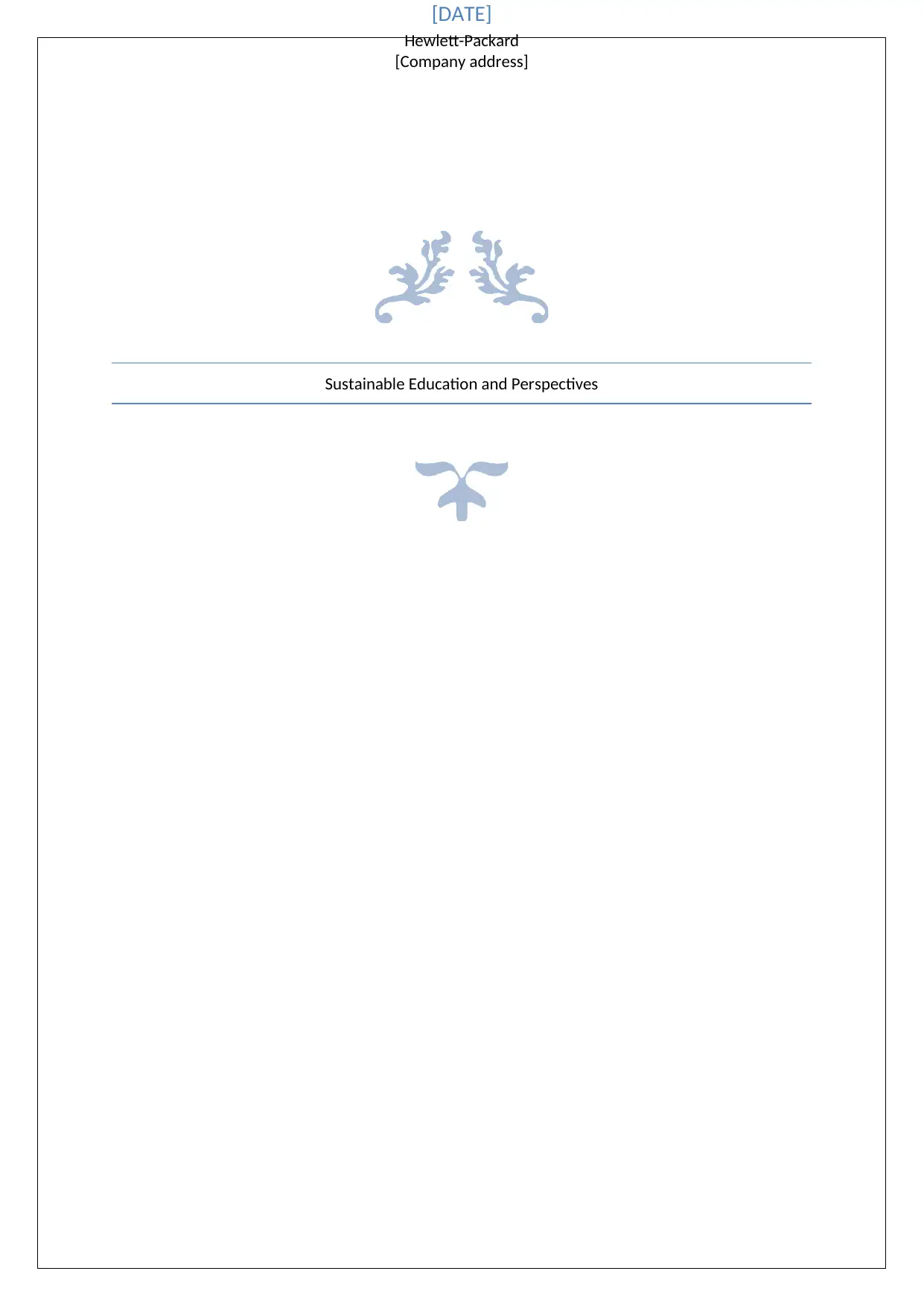
Sustainable Education and Perspectives
[DATE]
Hewlett-Packard
[Company address]
[DATE]
Hewlett-Packard
[Company address]
Secure Best Marks with AI Grader
Need help grading? Try our AI Grader for instant feedback on your assignments.
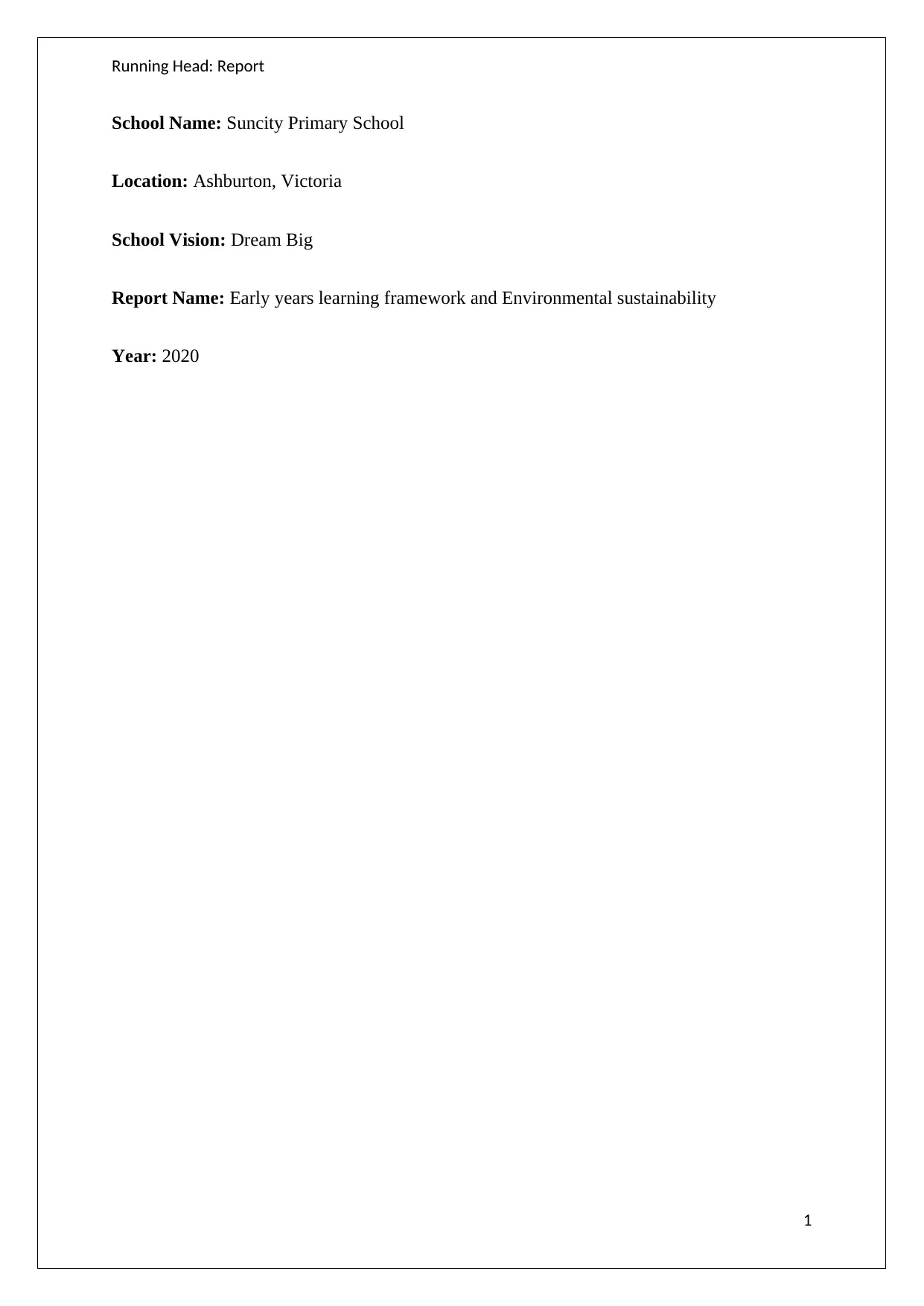
Running Head: Report
School Name: Suncity Primary School
Location: Ashburton, Victoria
School Vision: Dream Big
Report Name: Early years learning framework and Environmental sustainability
Year: 2020
1
School Name: Suncity Primary School
Location: Ashburton, Victoria
School Vision: Dream Big
Report Name: Early years learning framework and Environmental sustainability
Year: 2020
1
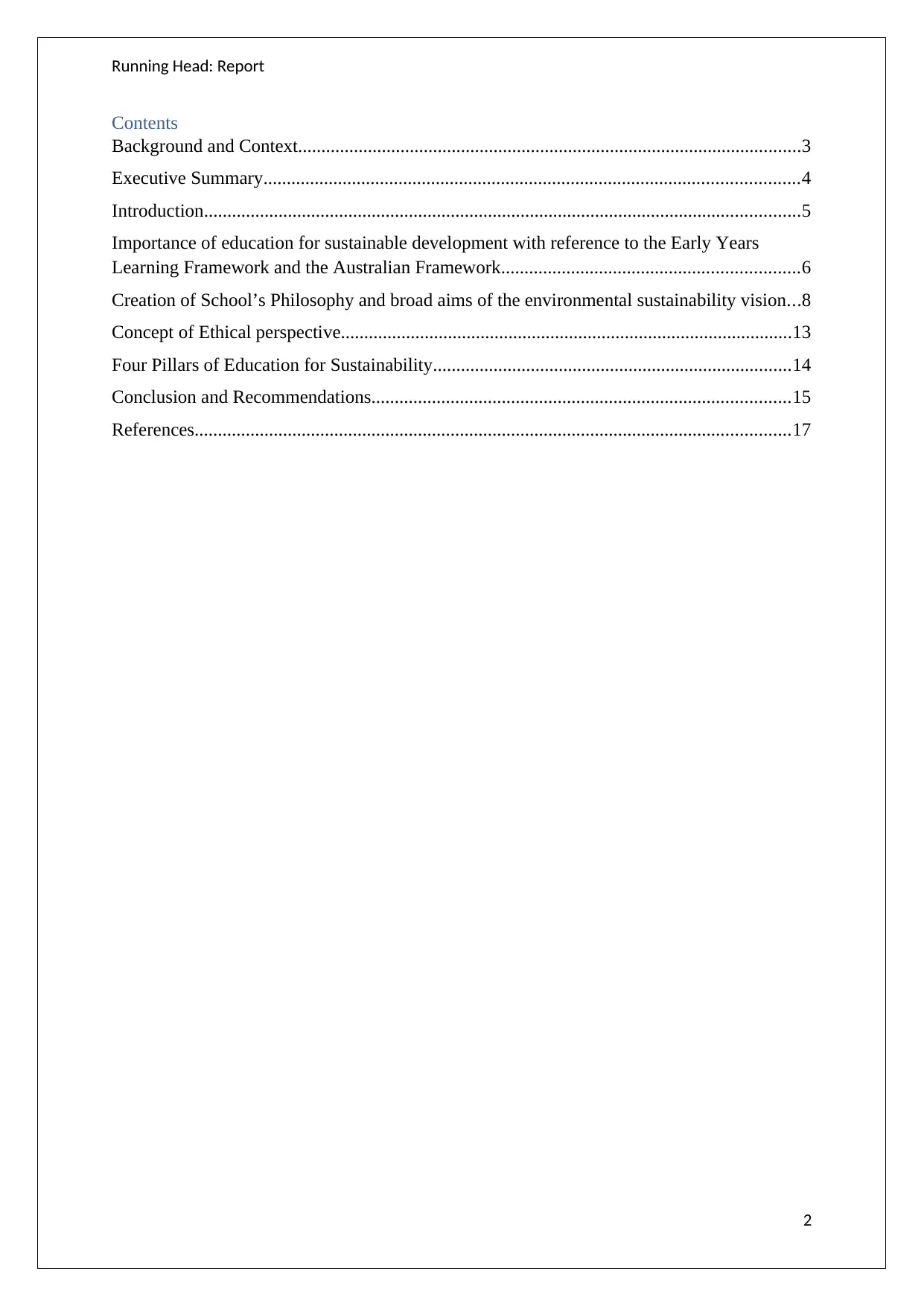
Running Head: Report
Contents
Background and Context............................................................................................................3
Executive Summary...................................................................................................................4
Introduction................................................................................................................................5
Importance of education for sustainable development with reference to the Early Years
Learning Framework and the Australian Framework................................................................6
Creation of School’s Philosophy and broad aims of the environmental sustainability vision...8
Concept of Ethical perspective.................................................................................................13
Four Pillars of Education for Sustainability.............................................................................14
Conclusion and Recommendations..........................................................................................15
References................................................................................................................................17
2
Contents
Background and Context............................................................................................................3
Executive Summary...................................................................................................................4
Introduction................................................................................................................................5
Importance of education for sustainable development with reference to the Early Years
Learning Framework and the Australian Framework................................................................6
Creation of School’s Philosophy and broad aims of the environmental sustainability vision...8
Concept of Ethical perspective.................................................................................................13
Four Pillars of Education for Sustainability.............................................................................14
Conclusion and Recommendations..........................................................................................15
References................................................................................................................................17
2
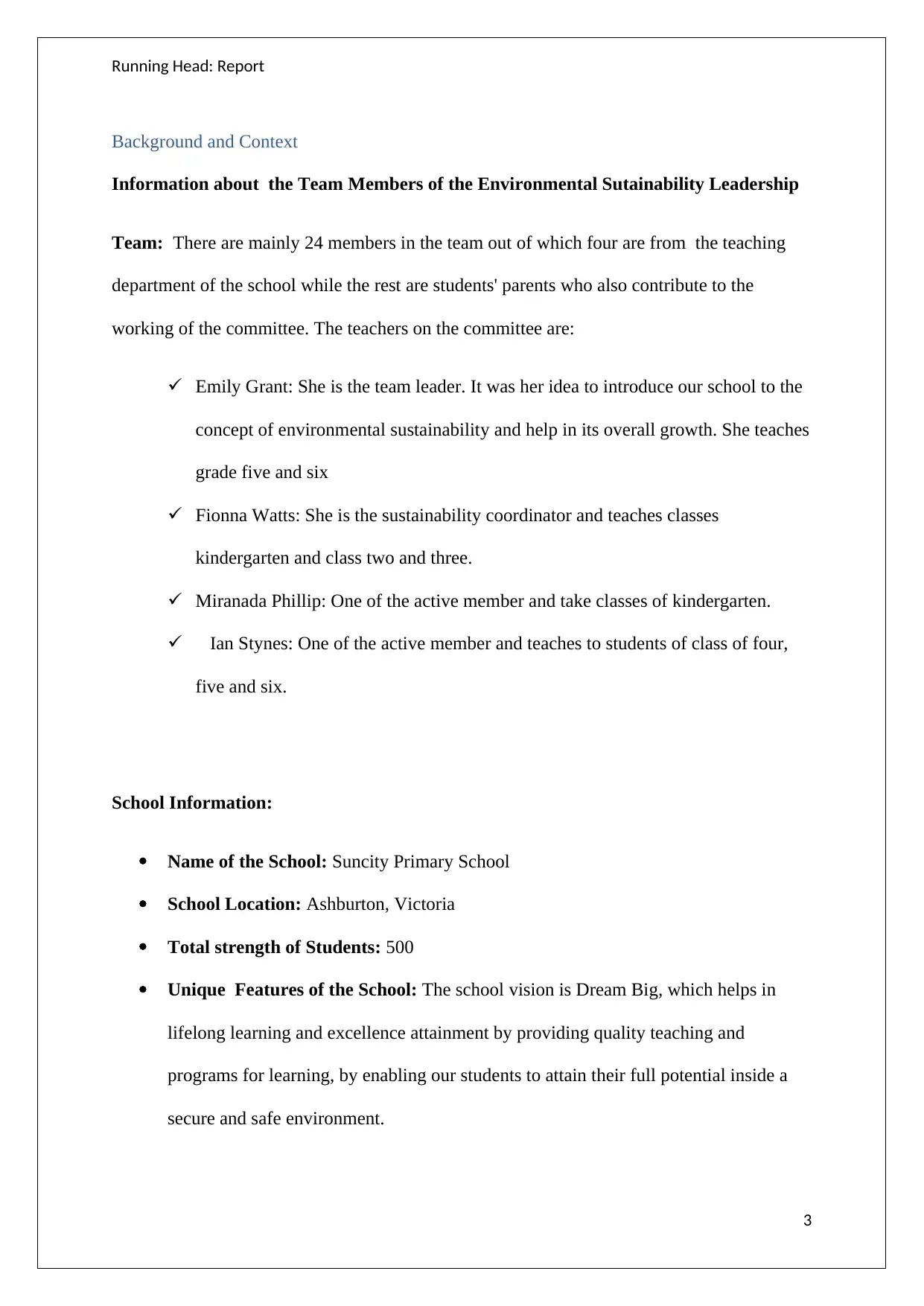
Running Head: Report
Background and Context
Information about the Team Members of the Environmental Sutainability Leadership
Team: There are mainly 24 members in the team out of which four are from the teaching
department of the school while the rest are students' parents who also contribute to the
working of the committee. The teachers on the committee are:
Emily Grant: She is the team leader. It was her idea to introduce our school to the
concept of environmental sustainability and help in its overall growth. She teaches
grade five and six
Fionna Watts: She is the sustainability coordinator and teaches classes
kindergarten and class two and three.
Miranada Phillip: One of the active member and take classes of kindergarten.
Ian Stynes: One of the active member and teaches to students of class of four,
five and six.
School Information:
Name of the School: Suncity Primary School
School Location: Ashburton, Victoria
Total strength of Students: 500
Unique Features of the School: The school vision is Dream Big, which helps in
lifelong learning and excellence attainment by providing quality teaching and
programs for learning, by enabling our students to attain their full potential inside a
secure and safe environment.
3
Background and Context
Information about the Team Members of the Environmental Sutainability Leadership
Team: There are mainly 24 members in the team out of which four are from the teaching
department of the school while the rest are students' parents who also contribute to the
working of the committee. The teachers on the committee are:
Emily Grant: She is the team leader. It was her idea to introduce our school to the
concept of environmental sustainability and help in its overall growth. She teaches
grade five and six
Fionna Watts: She is the sustainability coordinator and teaches classes
kindergarten and class two and three.
Miranada Phillip: One of the active member and take classes of kindergarten.
Ian Stynes: One of the active member and teaches to students of class of four,
five and six.
School Information:
Name of the School: Suncity Primary School
School Location: Ashburton, Victoria
Total strength of Students: 500
Unique Features of the School: The school vision is Dream Big, which helps in
lifelong learning and excellence attainment by providing quality teaching and
programs for learning, by enabling our students to attain their full potential inside a
secure and safe environment.
3
Secure Best Marks with AI Grader
Need help grading? Try our AI Grader for instant feedback on your assignments.
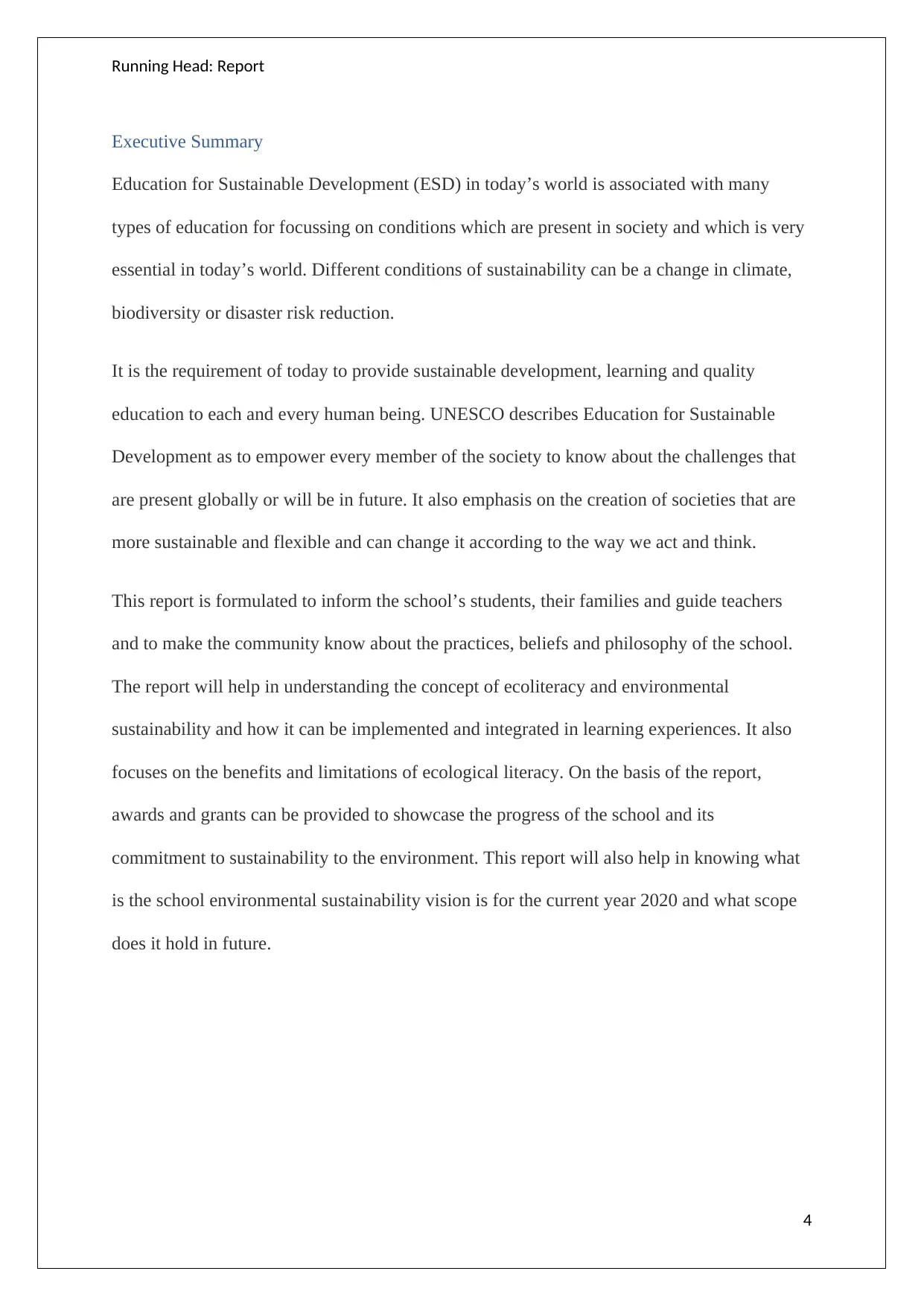
Running Head: Report
Executive Summary
Education for Sustainable Development (ESD) in today’s world is associated with many
types of education for focussing on conditions which are present in society and which is very
essential in today’s world. Different conditions of sustainability can be a change in climate,
biodiversity or disaster risk reduction.
It is the requirement of today to provide sustainable development, learning and quality
education to each and every human being. UNESCO describes Education for Sustainable
Development as to empower every member of the society to know about the challenges that
are present globally or will be in future. It also emphasis on the creation of societies that are
more sustainable and flexible and can change it according to the way we act and think.
This report is formulated to inform the school’s students, their families and guide teachers
and to make the community know about the practices, beliefs and philosophy of the school.
The report will help in understanding the concept of ecoliteracy and environmental
sustainability and how it can be implemented and integrated in learning experiences. It also
focuses on the benefits and limitations of ecological literacy. On the basis of the report,
awards and grants can be provided to showcase the progress of the school and its
commitment to sustainability to the environment. This report will also help in knowing what
is the school environmental sustainability vision is for the current year 2020 and what scope
does it hold in future.
4
Executive Summary
Education for Sustainable Development (ESD) in today’s world is associated with many
types of education for focussing on conditions which are present in society and which is very
essential in today’s world. Different conditions of sustainability can be a change in climate,
biodiversity or disaster risk reduction.
It is the requirement of today to provide sustainable development, learning and quality
education to each and every human being. UNESCO describes Education for Sustainable
Development as to empower every member of the society to know about the challenges that
are present globally or will be in future. It also emphasis on the creation of societies that are
more sustainable and flexible and can change it according to the way we act and think.
This report is formulated to inform the school’s students, their families and guide teachers
and to make the community know about the practices, beliefs and philosophy of the school.
The report will help in understanding the concept of ecoliteracy and environmental
sustainability and how it can be implemented and integrated in learning experiences. It also
focuses on the benefits and limitations of ecological literacy. On the basis of the report,
awards and grants can be provided to showcase the progress of the school and its
commitment to sustainability to the environment. This report will also help in knowing what
is the school environmental sustainability vision is for the current year 2020 and what scope
does it hold in future.
4
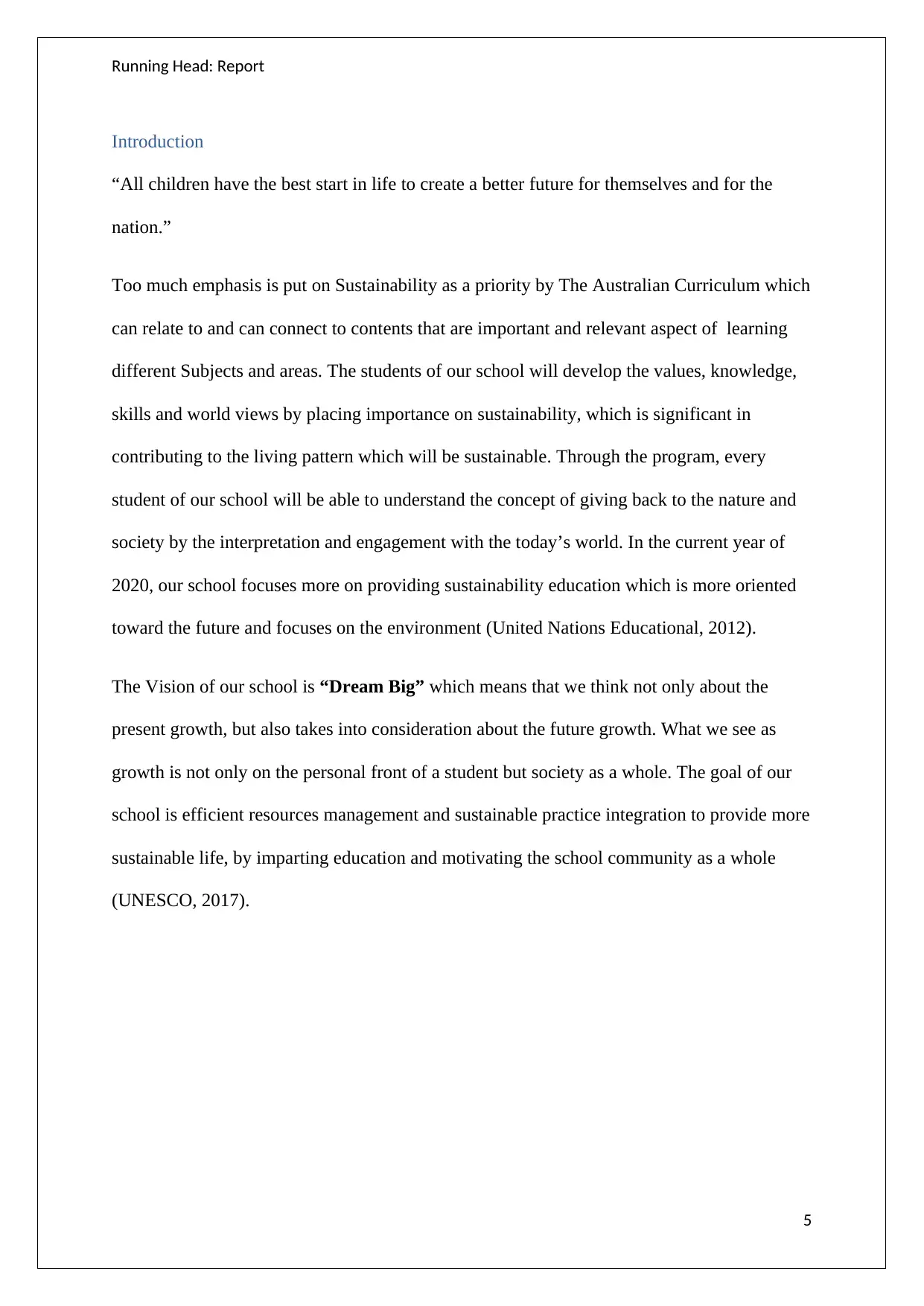
Running Head: Report
Introduction
“All children have the best start in life to create a better future for themselves and for the
nation.”
Too much emphasis is put on Sustainability as a priority by The Australian Curriculum which
can relate to and can connect to contents that are important and relevant aspect of learning
different Subjects and areas. The students of our school will develop the values, knowledge,
skills and world views by placing importance on sustainability, which is significant in
contributing to the living pattern which will be sustainable. Through the program, every
student of our school will be able to understand the concept of giving back to the nature and
society by the interpretation and engagement with the today’s world. In the current year of
2020, our school focuses more on providing sustainability education which is more oriented
toward the future and focuses on the environment (United Nations Educational, 2012).
The Vision of our school is “Dream Big” which means that we think not only about the
present growth, but also takes into consideration about the future growth. What we see as
growth is not only on the personal front of a student but society as a whole. The goal of our
school is efficient resources management and sustainable practice integration to provide more
sustainable life, by imparting education and motivating the school community as a whole
(UNESCO, 2017).
5
Introduction
“All children have the best start in life to create a better future for themselves and for the
nation.”
Too much emphasis is put on Sustainability as a priority by The Australian Curriculum which
can relate to and can connect to contents that are important and relevant aspect of learning
different Subjects and areas. The students of our school will develop the values, knowledge,
skills and world views by placing importance on sustainability, which is significant in
contributing to the living pattern which will be sustainable. Through the program, every
student of our school will be able to understand the concept of giving back to the nature and
society by the interpretation and engagement with the today’s world. In the current year of
2020, our school focuses more on providing sustainability education which is more oriented
toward the future and focuses on the environment (United Nations Educational, 2012).
The Vision of our school is “Dream Big” which means that we think not only about the
present growth, but also takes into consideration about the future growth. What we see as
growth is not only on the personal front of a student but society as a whole. The goal of our
school is efficient resources management and sustainable practice integration to provide more
sustainable life, by imparting education and motivating the school community as a whole
(UNESCO, 2017).
5
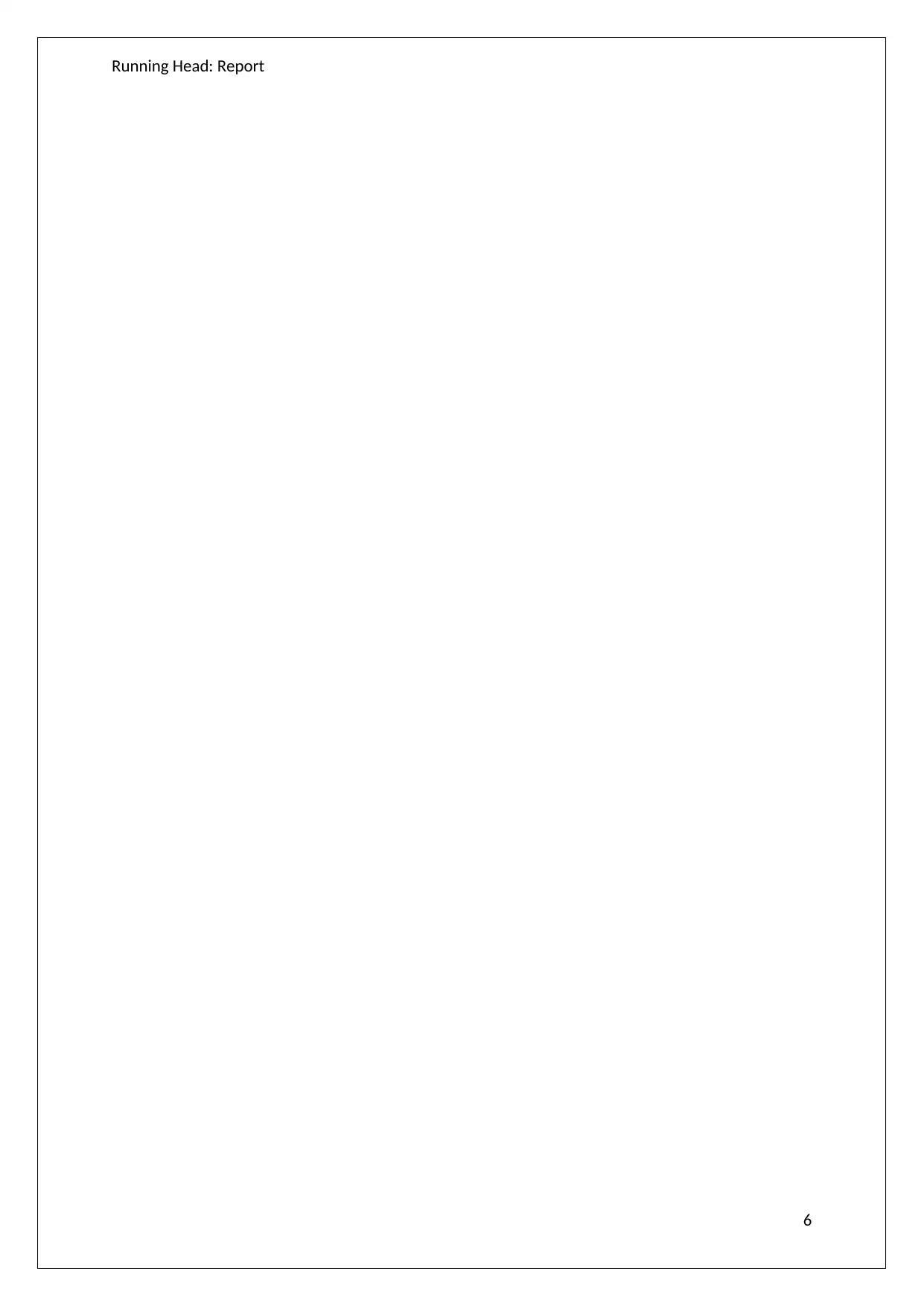
Running Head: Report
6
6
Paraphrase This Document
Need a fresh take? Get an instant paraphrase of this document with our AI Paraphraser
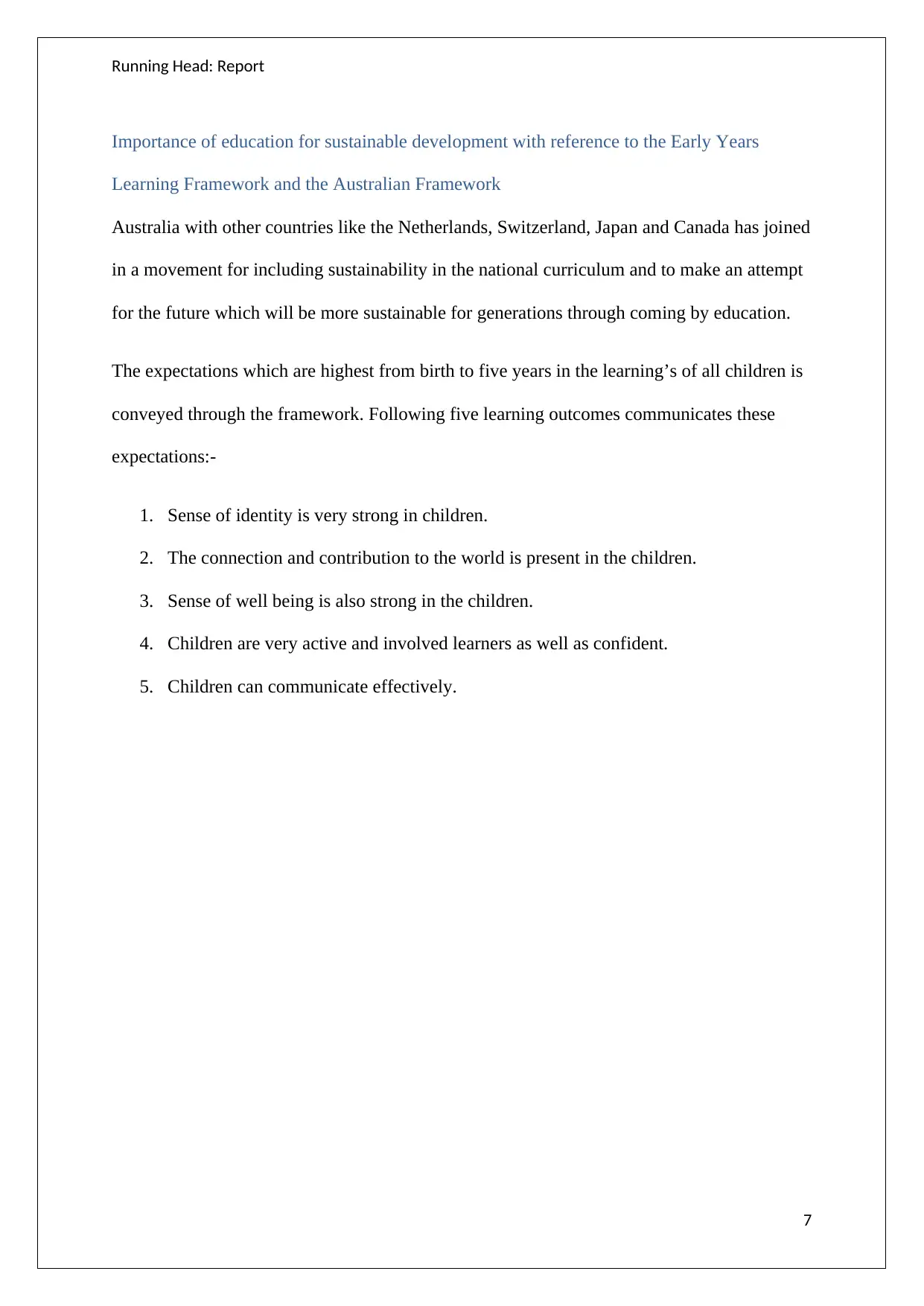
Running Head: Report
Importance of education for sustainable development with reference to the Early Years
Learning Framework and the Australian Framework
Australia with other countries like the Netherlands, Switzerland, Japan and Canada has joined
in a movement for including sustainability in the national curriculum and to make an attempt
for the future which will be more sustainable for generations through coming by education.
The expectations which are highest from birth to five years in the learning’s of all children is
conveyed through the framework. Following five learning outcomes communicates these
expectations:-
1. Sense of identity is very strong in children.
2. The connection and contribution to the world is present in the children.
3. Sense of well being is also strong in the children.
4. Children are very active and involved learners as well as confident.
5. Children can communicate effectively.
7
Importance of education for sustainable development with reference to the Early Years
Learning Framework and the Australian Framework
Australia with other countries like the Netherlands, Switzerland, Japan and Canada has joined
in a movement for including sustainability in the national curriculum and to make an attempt
for the future which will be more sustainable for generations through coming by education.
The expectations which are highest from birth to five years in the learning’s of all children is
conveyed through the framework. Following five learning outcomes communicates these
expectations:-
1. Sense of identity is very strong in children.
2. The connection and contribution to the world is present in the children.
3. Sense of well being is also strong in the children.
4. Children are very active and involved learners as well as confident.
5. Children can communicate effectively.
7
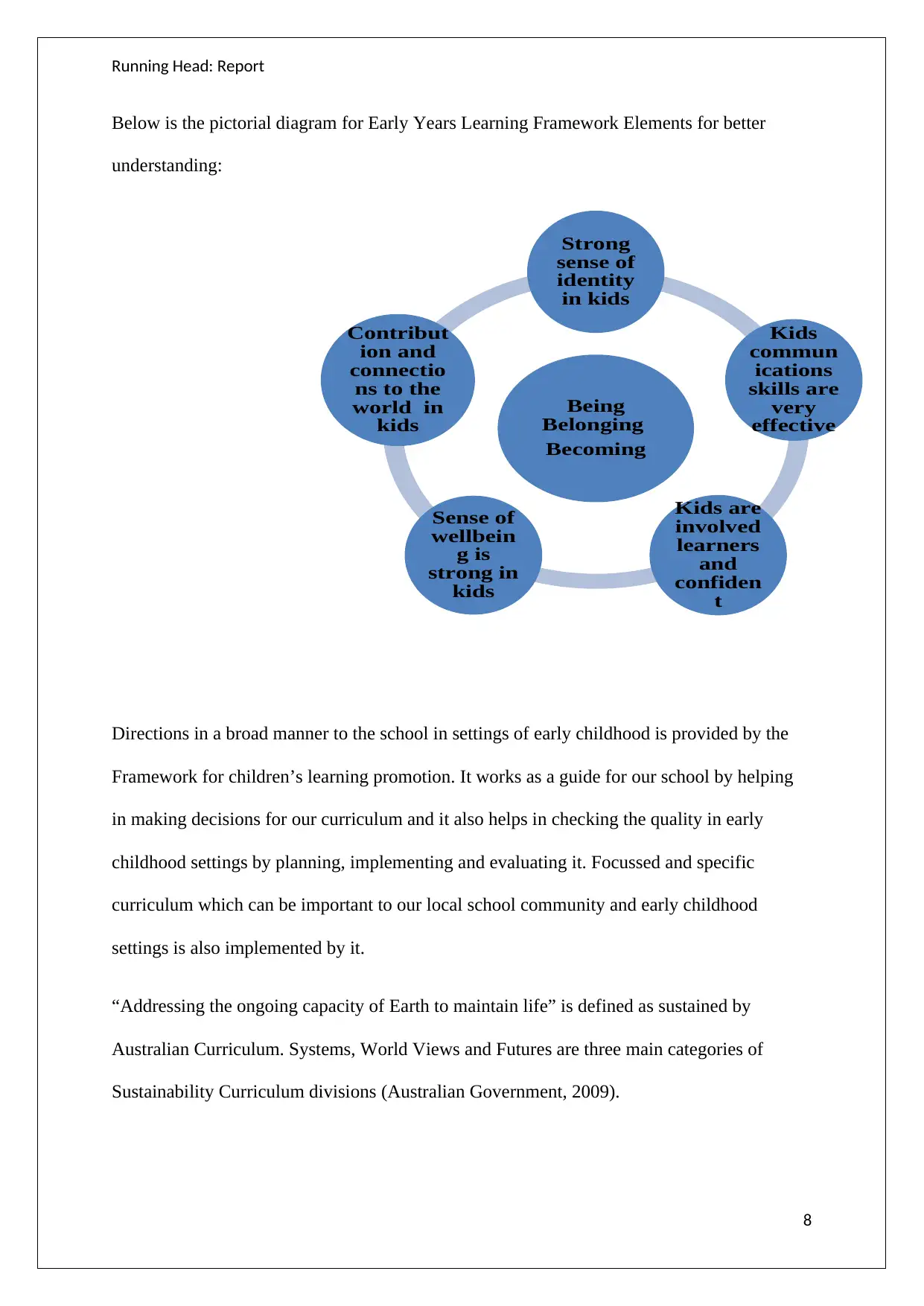
Running Head: Report
Below is the pictorial diagram for Early Years Learning Framework Elements for better
understanding:
Directions in a broad manner to the school in settings of early childhood is provided by the
Framework for children’s learning promotion. It works as a guide for our school by helping
in making decisions for our curriculum and it also helps in checking the quality in early
childhood settings by planning, implementing and evaluating it. Focussed and specific
curriculum which can be important to our local school community and early childhood
settings is also implemented by it.
“Addressing the ongoing capacity of Earth to maintain life” is defined as sustained by
Australian Curriculum. Systems, World Views and Futures are three main categories of
Sustainability Curriculum divisions (Australian Government, 2009).
8
Being
Belonging
Becoming
Strong
sense of
identity
in kids
Kids
commun
ications
skills are
very
effective
Kids are
involved
learners
and
confiden
t
Sense of
wellbein
g is
strong in
kids
Contribut
ion and
connectio
ns to the
world in
kids
Below is the pictorial diagram for Early Years Learning Framework Elements for better
understanding:
Directions in a broad manner to the school in settings of early childhood is provided by the
Framework for children’s learning promotion. It works as a guide for our school by helping
in making decisions for our curriculum and it also helps in checking the quality in early
childhood settings by planning, implementing and evaluating it. Focussed and specific
curriculum which can be important to our local school community and early childhood
settings is also implemented by it.
“Addressing the ongoing capacity of Earth to maintain life” is defined as sustained by
Australian Curriculum. Systems, World Views and Futures are three main categories of
Sustainability Curriculum divisions (Australian Government, 2009).
8
Being
Belonging
Becoming
Strong
sense of
identity
in kids
Kids
commun
ications
skills are
very
effective
Kids are
involved
learners
and
confiden
t
Sense of
wellbein
g is
strong in
kids
Contribut
ion and
connectio
ns to the
world in
kids

Running Head: Report
There is a need for actions which are drastic throughout at all societal levels like businesses,
schools, communities and government. To prepare kids to enable them to lead and live more
sustainable lives, imparting education in kids of all age groups and schooling level is
included.
Creation of School’s Philosophy and broad aims of the environmental sustainability vision
The vision of our school is “Dream Big” and it is only possible if we as a team can work for
the educational sustainability and making the school children eco-literate and prepare for a
better future.
Anticipatory thinking, foresight or transgenerational thinking is few terms used for future
thinking. Future thinking is required for sustainability and its includes the ability to analyze
collectively, evaluate and draw pictures related to the future issues of sustainability and
problem solving frameworks for sustainability (Alliance, 2014).
Our school knows the importance of educating the school children concept of sustainability
and making them eco-literate, who in turn will educate their parents and society. Our school
philosophy is to consider the futures which are logical in a broad range, such that the society
can be educated and a more sustainable future can be created. By starting to engage students,
especially those in the age group of 3-6 years to 12 years, finite numbers of outcomes of
actions and decisions, futures thinking can be used in the classroom.
We will also like to implement scenarios in our school teachings wherein, the teachers use
tools and means to implement for helping students in expanding their ways of thinking about
how the world from today’s world, that is a world from 2020 world will be and what will it
contain for them (Solway Primary School, 2015).
9
There is a need for actions which are drastic throughout at all societal levels like businesses,
schools, communities and government. To prepare kids to enable them to lead and live more
sustainable lives, imparting education in kids of all age groups and schooling level is
included.
Creation of School’s Philosophy and broad aims of the environmental sustainability vision
The vision of our school is “Dream Big” and it is only possible if we as a team can work for
the educational sustainability and making the school children eco-literate and prepare for a
better future.
Anticipatory thinking, foresight or transgenerational thinking is few terms used for future
thinking. Future thinking is required for sustainability and its includes the ability to analyze
collectively, evaluate and draw pictures related to the future issues of sustainability and
problem solving frameworks for sustainability (Alliance, 2014).
Our school knows the importance of educating the school children concept of sustainability
and making them eco-literate, who in turn will educate their parents and society. Our school
philosophy is to consider the futures which are logical in a broad range, such that the society
can be educated and a more sustainable future can be created. By starting to engage students,
especially those in the age group of 3-6 years to 12 years, finite numbers of outcomes of
actions and decisions, futures thinking can be used in the classroom.
We will also like to implement scenarios in our school teachings wherein, the teachers use
tools and means to implement for helping students in expanding their ways of thinking about
how the world from today’s world, that is a world from 2020 world will be and what will it
contain for them (Solway Primary School, 2015).
9
Secure Best Marks with AI Grader
Need help grading? Try our AI Grader for instant feedback on your assignments.
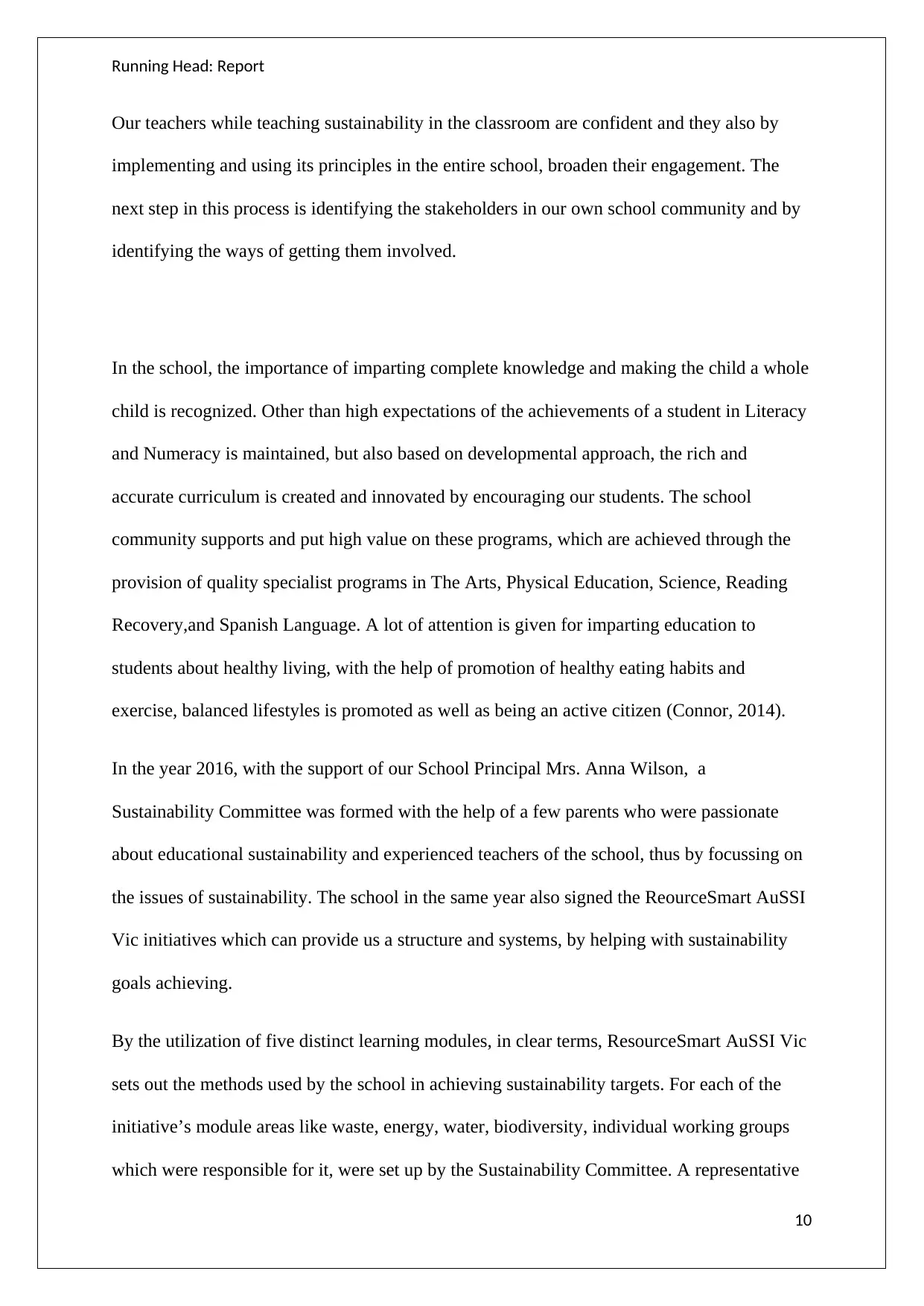
Running Head: Report
Our teachers while teaching sustainability in the classroom are confident and they also by
implementing and using its principles in the entire school, broaden their engagement. The
next step in this process is identifying the stakeholders in our own school community and by
identifying the ways of getting them involved.
In the school, the importance of imparting complete knowledge and making the child a whole
child is recognized. Other than high expectations of the achievements of a student in Literacy
and Numeracy is maintained, but also based on developmental approach, the rich and
accurate curriculum is created and innovated by encouraging our students. The school
community supports and put high value on these programs, which are achieved through the
provision of quality specialist programs in The Arts, Physical Education, Science, Reading
Recovery,and Spanish Language. A lot of attention is given for imparting education to
students about healthy living, with the help of promotion of healthy eating habits and
exercise, balanced lifestyles is promoted as well as being an active citizen (Connor, 2014).
In the year 2016, with the support of our School Principal Mrs. Anna Wilson, a
Sustainability Committee was formed with the help of a few parents who were passionate
about educational sustainability and experienced teachers of the school, thus by focussing on
the issues of sustainability. The school in the same year also signed the ReourceSmart AuSSI
Vic initiatives which can provide us a structure and systems, by helping with sustainability
goals achieving.
By the utilization of five distinct learning modules, in clear terms, ResourceSmart AuSSI Vic
sets out the methods used by the school in achieving sustainability targets. For each of the
initiative’s module areas like waste, energy, water, biodiversity, individual working groups
which were responsible for it, were set up by the Sustainability Committee. A representative
10
Our teachers while teaching sustainability in the classroom are confident and they also by
implementing and using its principles in the entire school, broaden their engagement. The
next step in this process is identifying the stakeholders in our own school community and by
identifying the ways of getting them involved.
In the school, the importance of imparting complete knowledge and making the child a whole
child is recognized. Other than high expectations of the achievements of a student in Literacy
and Numeracy is maintained, but also based on developmental approach, the rich and
accurate curriculum is created and innovated by encouraging our students. The school
community supports and put high value on these programs, which are achieved through the
provision of quality specialist programs in The Arts, Physical Education, Science, Reading
Recovery,and Spanish Language. A lot of attention is given for imparting education to
students about healthy living, with the help of promotion of healthy eating habits and
exercise, balanced lifestyles is promoted as well as being an active citizen (Connor, 2014).
In the year 2016, with the support of our School Principal Mrs. Anna Wilson, a
Sustainability Committee was formed with the help of a few parents who were passionate
about educational sustainability and experienced teachers of the school, thus by focussing on
the issues of sustainability. The school in the same year also signed the ReourceSmart AuSSI
Vic initiatives which can provide us a structure and systems, by helping with sustainability
goals achieving.
By the utilization of five distinct learning modules, in clear terms, ResourceSmart AuSSI Vic
sets out the methods used by the school in achieving sustainability targets. For each of the
initiative’s module areas like waste, energy, water, biodiversity, individual working groups
which were responsible for it, were set up by the Sustainability Committee. A representative
10
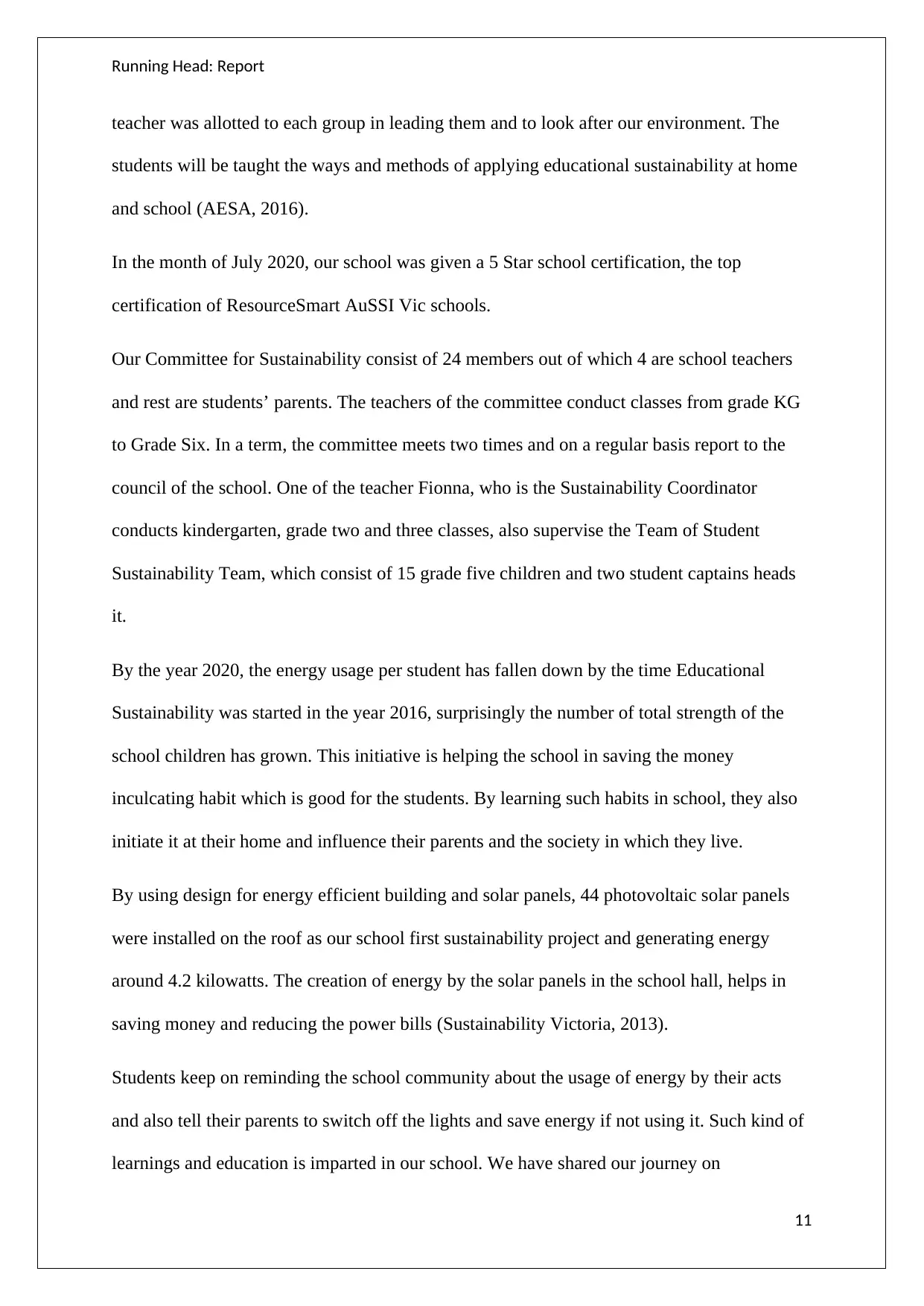
Running Head: Report
teacher was allotted to each group in leading them and to look after our environment. The
students will be taught the ways and methods of applying educational sustainability at home
and school (AESA, 2016).
In the month of July 2020, our school was given a 5 Star school certification, the top
certification of ResourceSmart AuSSI Vic schools.
Our Committee for Sustainability consist of 24 members out of which 4 are school teachers
and rest are students’ parents. The teachers of the committee conduct classes from grade KG
to Grade Six. In a term, the committee meets two times and on a regular basis report to the
council of the school. One of the teacher Fionna, who is the Sustainability Coordinator
conducts kindergarten, grade two and three classes, also supervise the Team of Student
Sustainability Team, which consist of 15 grade five children and two student captains heads
it.
By the year 2020, the energy usage per student has fallen down by the time Educational
Sustainability was started in the year 2016, surprisingly the number of total strength of the
school children has grown. This initiative is helping the school in saving the money
inculcating habit which is good for the students. By learning such habits in school, they also
initiate it at their home and influence their parents and the society in which they live.
By using design for energy efficient building and solar panels, 44 photovoltaic solar panels
were installed on the roof as our school first sustainability project and generating energy
around 4.2 kilowatts. The creation of energy by the solar panels in the school hall, helps in
saving money and reducing the power bills (Sustainability Victoria, 2013).
Students keep on reminding the school community about the usage of energy by their acts
and also tell their parents to switch off the lights and save energy if not using it. Such kind of
learnings and education is imparted in our school. We have shared our journey on
11
teacher was allotted to each group in leading them and to look after our environment. The
students will be taught the ways and methods of applying educational sustainability at home
and school (AESA, 2016).
In the month of July 2020, our school was given a 5 Star school certification, the top
certification of ResourceSmart AuSSI Vic schools.
Our Committee for Sustainability consist of 24 members out of which 4 are school teachers
and rest are students’ parents. The teachers of the committee conduct classes from grade KG
to Grade Six. In a term, the committee meets two times and on a regular basis report to the
council of the school. One of the teacher Fionna, who is the Sustainability Coordinator
conducts kindergarten, grade two and three classes, also supervise the Team of Student
Sustainability Team, which consist of 15 grade five children and two student captains heads
it.
By the year 2020, the energy usage per student has fallen down by the time Educational
Sustainability was started in the year 2016, surprisingly the number of total strength of the
school children has grown. This initiative is helping the school in saving the money
inculcating habit which is good for the students. By learning such habits in school, they also
initiate it at their home and influence their parents and the society in which they live.
By using design for energy efficient building and solar panels, 44 photovoltaic solar panels
were installed on the roof as our school first sustainability project and generating energy
around 4.2 kilowatts. The creation of energy by the solar panels in the school hall, helps in
saving money and reducing the power bills (Sustainability Victoria, 2013).
Students keep on reminding the school community about the usage of energy by their acts
and also tell their parents to switch off the lights and save energy if not using it. Such kind of
learnings and education is imparted in our school. We have shared our journey on
11
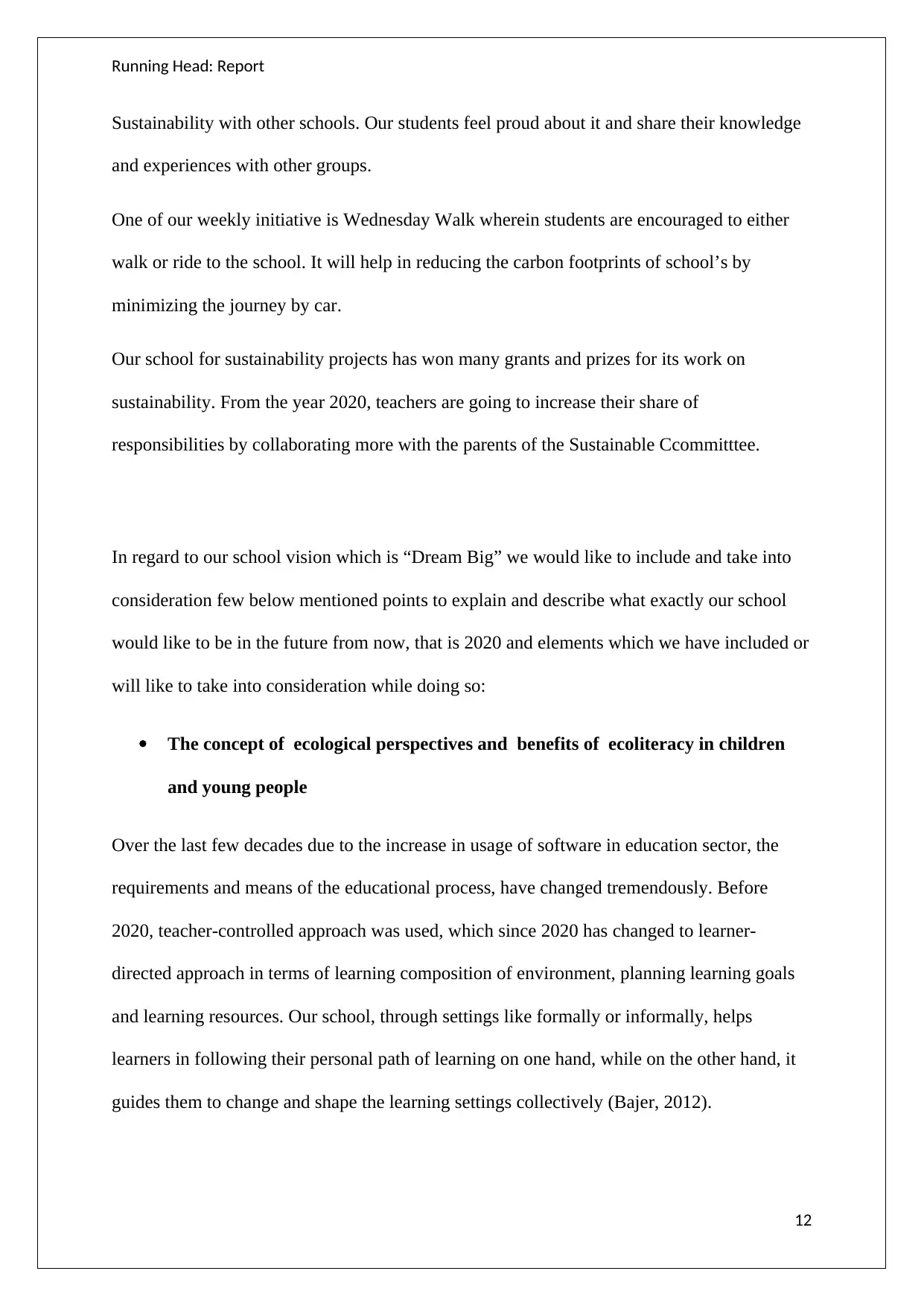
Running Head: Report
Sustainability with other schools. Our students feel proud about it and share their knowledge
and experiences with other groups.
One of our weekly initiative is Wednesday Walk wherein students are encouraged to either
walk or ride to the school. It will help in reducing the carbon footprints of school’s by
minimizing the journey by car.
Our school for sustainability projects has won many grants and prizes for its work on
sustainability. From the year 2020, teachers are going to increase their share of
responsibilities by collaborating more with the parents of the Sustainable Ccommitttee.
In regard to our school vision which is “Dream Big” we would like to include and take into
consideration few below mentioned points to explain and describe what exactly our school
would like to be in the future from now, that is 2020 and elements which we have included or
will like to take into consideration while doing so:
The concept of ecological perspectives and benefits of ecoliteracy in children
and young people
Over the last few decades due to the increase in usage of software in education sector, the
requirements and means of the educational process, have changed tremendously. Before
2020, teacher-controlled approach was used, which since 2020 has changed to learner-
directed approach in terms of learning composition of environment, planning learning goals
and learning resources. Our school, through settings like formally or informally, helps
learners in following their personal path of learning on one hand, while on the other hand, it
guides them to change and shape the learning settings collectively (Bajer, 2012).
12
Sustainability with other schools. Our students feel proud about it and share their knowledge
and experiences with other groups.
One of our weekly initiative is Wednesday Walk wherein students are encouraged to either
walk or ride to the school. It will help in reducing the carbon footprints of school’s by
minimizing the journey by car.
Our school for sustainability projects has won many grants and prizes for its work on
sustainability. From the year 2020, teachers are going to increase their share of
responsibilities by collaborating more with the parents of the Sustainable Ccommitttee.
In regard to our school vision which is “Dream Big” we would like to include and take into
consideration few below mentioned points to explain and describe what exactly our school
would like to be in the future from now, that is 2020 and elements which we have included or
will like to take into consideration while doing so:
The concept of ecological perspectives and benefits of ecoliteracy in children
and young people
Over the last few decades due to the increase in usage of software in education sector, the
requirements and means of the educational process, have changed tremendously. Before
2020, teacher-controlled approach was used, which since 2020 has changed to learner-
directed approach in terms of learning composition of environment, planning learning goals
and learning resources. Our school, through settings like formally or informally, helps
learners in following their personal path of learning on one hand, while on the other hand, it
guides them to change and shape the learning settings collectively (Bajer, 2012).
12
Paraphrase This Document
Need a fresh take? Get an instant paraphrase of this document with our AI Paraphraser
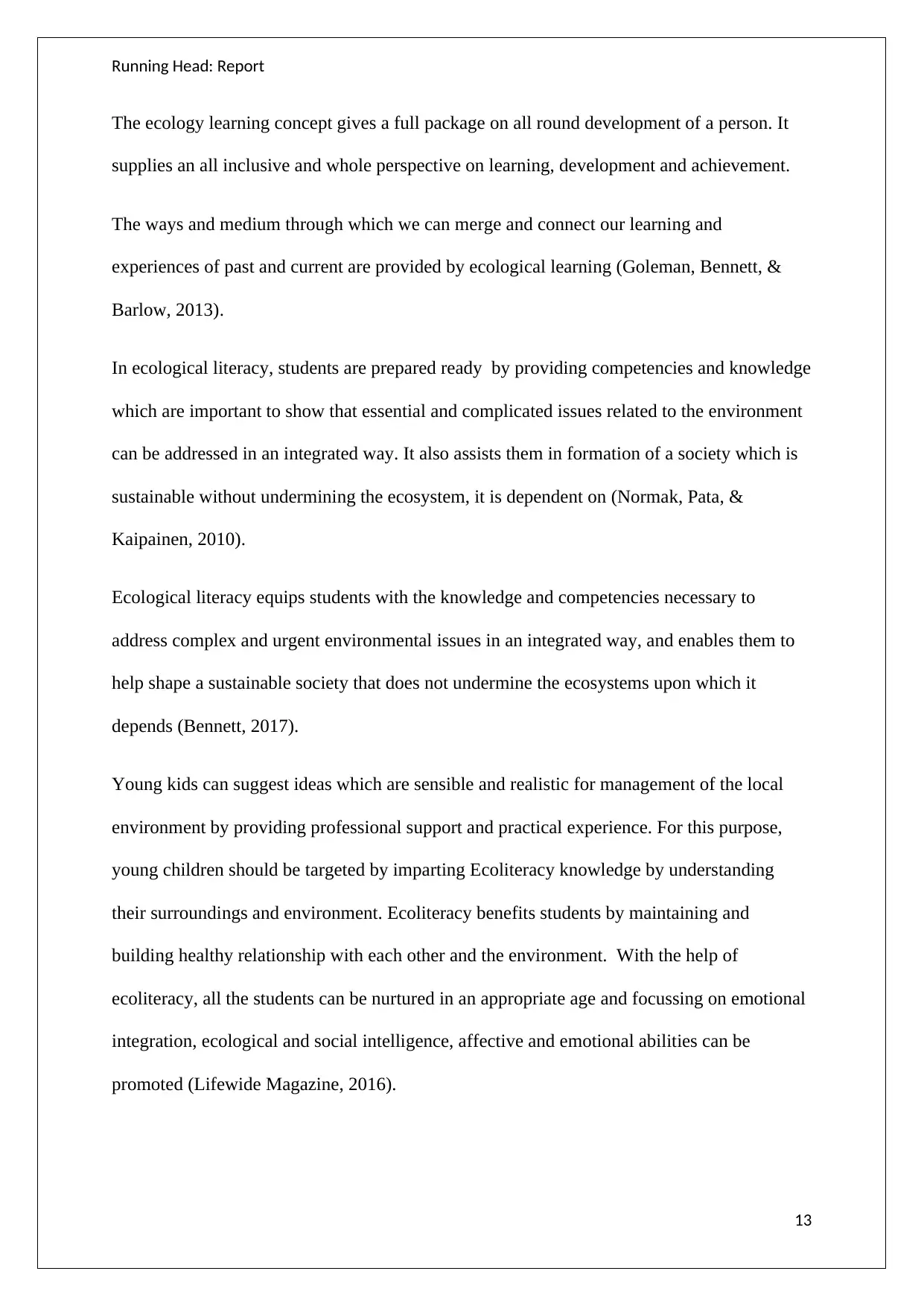
Running Head: Report
The ecology learning concept gives a full package on all round development of a person. It
supplies an all inclusive and whole perspective on learning, development and achievement.
The ways and medium through which we can merge and connect our learning and
experiences of past and current are provided by ecological learning (Goleman, Bennett, &
Barlow, 2013).
In ecological literacy, students are prepared ready by providing competencies and knowledge
which are important to show that essential and complicated issues related to the environment
can be addressed in an integrated way. It also assists them in formation of a society which is
sustainable without undermining the ecosystem, it is dependent on (Normak, Pata, &
Kaipainen, 2010).
Ecological literacy equips students with the knowledge and competencies necessary to
address complex and urgent environmental issues in an integrated way, and enables them to
help shape a sustainable society that does not undermine the ecosystems upon which it
depends (Bennett, 2017).
Young kids can suggest ideas which are sensible and realistic for management of the local
environment by providing professional support and practical experience. For this purpose,
young children should be targeted by imparting Ecoliteracy knowledge by understanding
their surroundings and environment. Ecoliteracy benefits students by maintaining and
building healthy relationship with each other and the environment. With the help of
ecoliteracy, all the students can be nurtured in an appropriate age and focussing on emotional
integration, ecological and social intelligence, affective and emotional abilities can be
promoted (Lifewide Magazine, 2016).
13
The ecology learning concept gives a full package on all round development of a person. It
supplies an all inclusive and whole perspective on learning, development and achievement.
The ways and medium through which we can merge and connect our learning and
experiences of past and current are provided by ecological learning (Goleman, Bennett, &
Barlow, 2013).
In ecological literacy, students are prepared ready by providing competencies and knowledge
which are important to show that essential and complicated issues related to the environment
can be addressed in an integrated way. It also assists them in formation of a society which is
sustainable without undermining the ecosystem, it is dependent on (Normak, Pata, &
Kaipainen, 2010).
Ecological literacy equips students with the knowledge and competencies necessary to
address complex and urgent environmental issues in an integrated way, and enables them to
help shape a sustainable society that does not undermine the ecosystems upon which it
depends (Bennett, 2017).
Young kids can suggest ideas which are sensible and realistic for management of the local
environment by providing professional support and practical experience. For this purpose,
young children should be targeted by imparting Ecoliteracy knowledge by understanding
their surroundings and environment. Ecoliteracy benefits students by maintaining and
building healthy relationship with each other and the environment. With the help of
ecoliteracy, all the students can be nurtured in an appropriate age and focussing on emotional
integration, ecological and social intelligence, affective and emotional abilities can be
promoted (Lifewide Magazine, 2016).
13
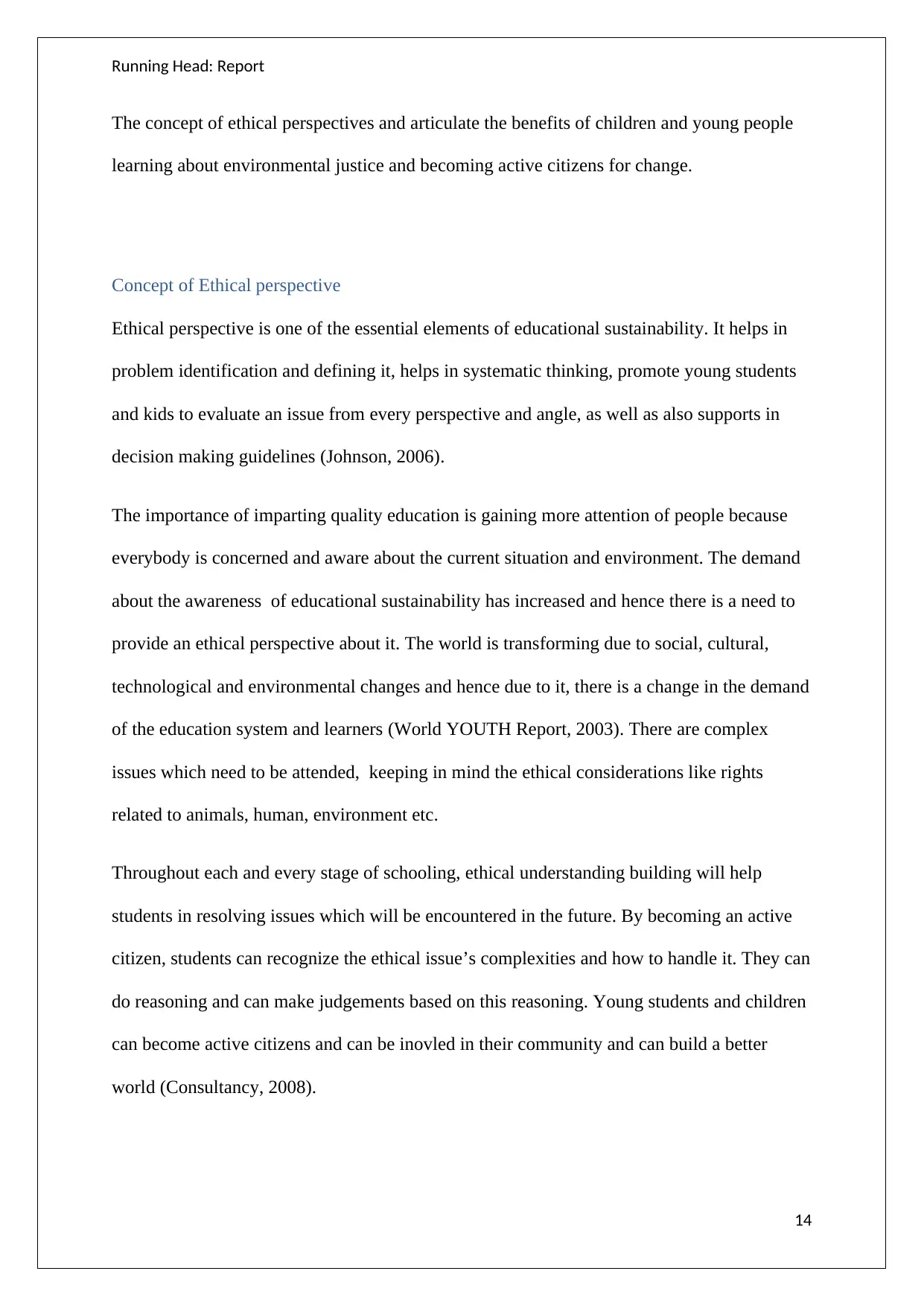
Running Head: Report
The concept of ethical perspectives and articulate the benefits of children and young people
learning about environmental justice and becoming active citizens for change.
Concept of Ethical perspective
Ethical perspective is one of the essential elements of educational sustainability. It helps in
problem identification and defining it, helps in systematic thinking, promote young students
and kids to evaluate an issue from every perspective and angle, as well as also supports in
decision making guidelines (Johnson, 2006).
The importance of imparting quality education is gaining more attention of people because
everybody is concerned and aware about the current situation and environment. The demand
about the awareness of educational sustainability has increased and hence there is a need to
provide an ethical perspective about it. The world is transforming due to social, cultural,
technological and environmental changes and hence due to it, there is a change in the demand
of the education system and learners (World YOUTH Report, 2003). There are complex
issues which need to be attended, keeping in mind the ethical considerations like rights
related to animals, human, environment etc.
Throughout each and every stage of schooling, ethical understanding building will help
students in resolving issues which will be encountered in the future. By becoming an active
citizen, students can recognize the ethical issue’s complexities and how to handle it. They can
do reasoning and can make judgements based on this reasoning. Young students and children
can become active citizens and can be inovled in their community and can build a better
world (Consultancy, 2008).
14
The concept of ethical perspectives and articulate the benefits of children and young people
learning about environmental justice and becoming active citizens for change.
Concept of Ethical perspective
Ethical perspective is one of the essential elements of educational sustainability. It helps in
problem identification and defining it, helps in systematic thinking, promote young students
and kids to evaluate an issue from every perspective and angle, as well as also supports in
decision making guidelines (Johnson, 2006).
The importance of imparting quality education is gaining more attention of people because
everybody is concerned and aware about the current situation and environment. The demand
about the awareness of educational sustainability has increased and hence there is a need to
provide an ethical perspective about it. The world is transforming due to social, cultural,
technological and environmental changes and hence due to it, there is a change in the demand
of the education system and learners (World YOUTH Report, 2003). There are complex
issues which need to be attended, keeping in mind the ethical considerations like rights
related to animals, human, environment etc.
Throughout each and every stage of schooling, ethical understanding building will help
students in resolving issues which will be encountered in the future. By becoming an active
citizen, students can recognize the ethical issue’s complexities and how to handle it. They can
do reasoning and can make judgements based on this reasoning. Young students and children
can become active citizens and can be inovled in their community and can build a better
world (Consultancy, 2008).
14
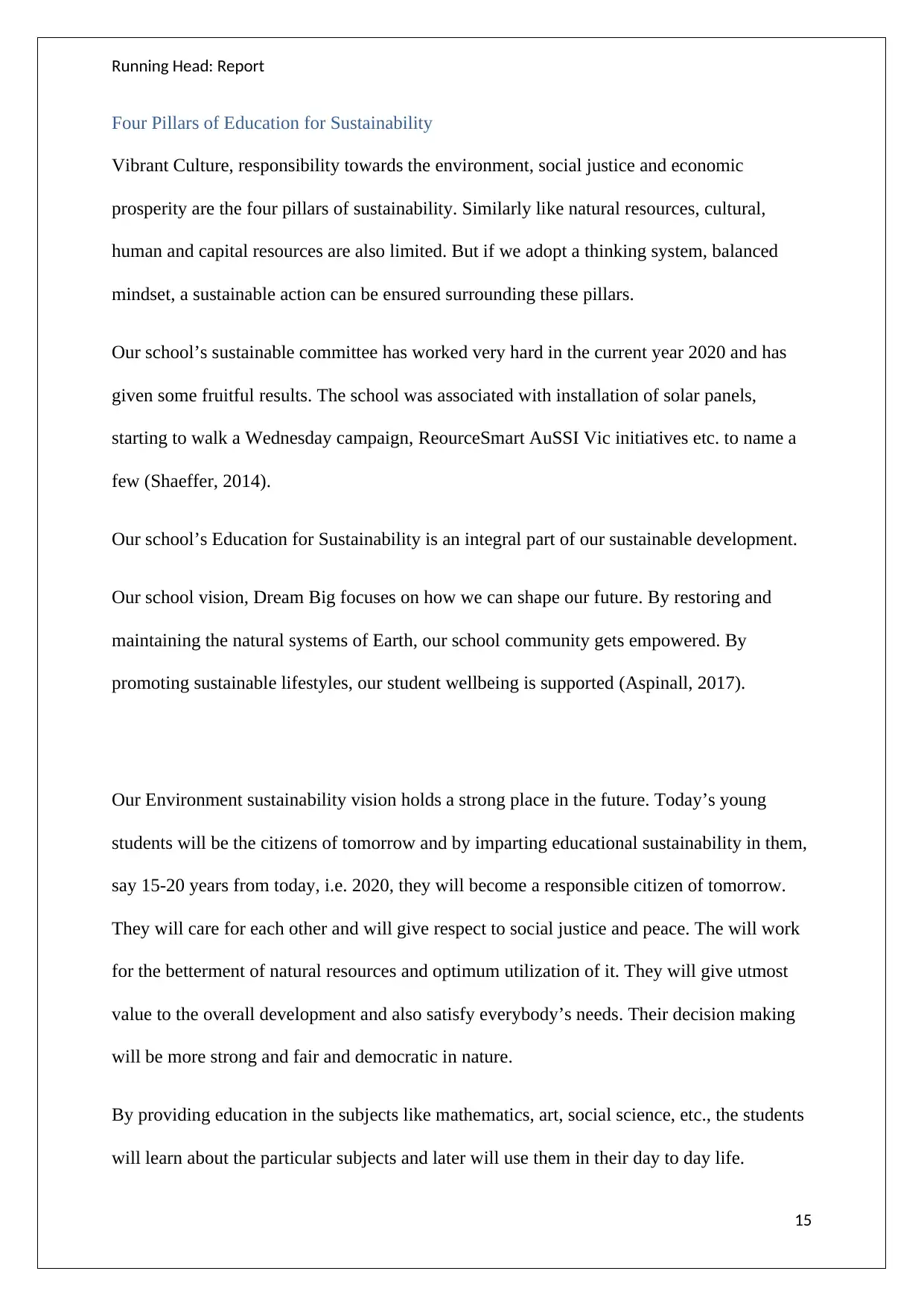
Running Head: Report
Four Pillars of Education for Sustainability
Vibrant Culture, responsibility towards the environment, social justice and economic
prosperity are the four pillars of sustainability. Similarly like natural resources, cultural,
human and capital resources are also limited. But if we adopt a thinking system, balanced
mindset, a sustainable action can be ensured surrounding these pillars.
Our school’s sustainable committee has worked very hard in the current year 2020 and has
given some fruitful results. The school was associated with installation of solar panels,
starting to walk a Wednesday campaign, ReourceSmart AuSSI Vic initiatives etc. to name a
few (Shaeffer, 2014).
Our school’s Education for Sustainability is an integral part of our sustainable development.
Our school vision, Dream Big focuses on how we can shape our future. By restoring and
maintaining the natural systems of Earth, our school community gets empowered. By
promoting sustainable lifestyles, our student wellbeing is supported (Aspinall, 2017).
Our Environment sustainability vision holds a strong place in the future. Today’s young
students will be the citizens of tomorrow and by imparting educational sustainability in them,
say 15-20 years from today, i.e. 2020, they will become a responsible citizen of tomorrow.
They will care for each other and will give respect to social justice and peace. The will work
for the betterment of natural resources and optimum utilization of it. They will give utmost
value to the overall development and also satisfy everybody’s needs. Their decision making
will be more strong and fair and democratic in nature.
By providing education in the subjects like mathematics, art, social science, etc., the students
will learn about the particular subjects and later will use them in their day to day life.
15
Four Pillars of Education for Sustainability
Vibrant Culture, responsibility towards the environment, social justice and economic
prosperity are the four pillars of sustainability. Similarly like natural resources, cultural,
human and capital resources are also limited. But if we adopt a thinking system, balanced
mindset, a sustainable action can be ensured surrounding these pillars.
Our school’s sustainable committee has worked very hard in the current year 2020 and has
given some fruitful results. The school was associated with installation of solar panels,
starting to walk a Wednesday campaign, ReourceSmart AuSSI Vic initiatives etc. to name a
few (Shaeffer, 2014).
Our school’s Education for Sustainability is an integral part of our sustainable development.
Our school vision, Dream Big focuses on how we can shape our future. By restoring and
maintaining the natural systems of Earth, our school community gets empowered. By
promoting sustainable lifestyles, our student wellbeing is supported (Aspinall, 2017).
Our Environment sustainability vision holds a strong place in the future. Today’s young
students will be the citizens of tomorrow and by imparting educational sustainability in them,
say 15-20 years from today, i.e. 2020, they will become a responsible citizen of tomorrow.
They will care for each other and will give respect to social justice and peace. The will work
for the betterment of natural resources and optimum utilization of it. They will give utmost
value to the overall development and also satisfy everybody’s needs. Their decision making
will be more strong and fair and democratic in nature.
By providing education in the subjects like mathematics, art, social science, etc., the students
will learn about the particular subjects and later will use them in their day to day life.
15
Secure Best Marks with AI Grader
Need help grading? Try our AI Grader for instant feedback on your assignments.
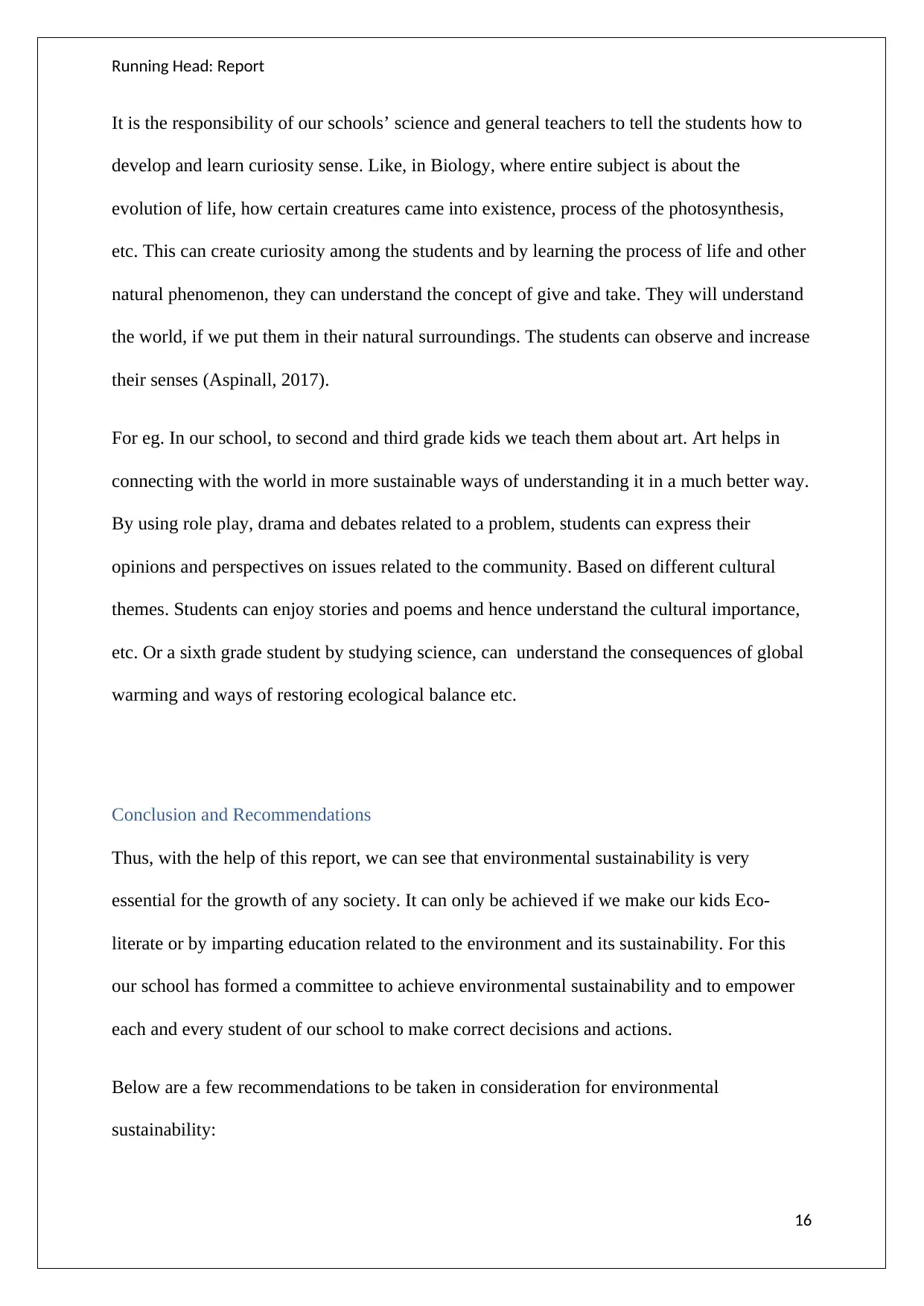
Running Head: Report
It is the responsibility of our schools’ science and general teachers to tell the students how to
develop and learn curiosity sense. Like, in Biology, where entire subject is about the
evolution of life, how certain creatures came into existence, process of the photosynthesis,
etc. This can create curiosity among the students and by learning the process of life and other
natural phenomenon, they can understand the concept of give and take. They will understand
the world, if we put them in their natural surroundings. The students can observe and increase
their senses (Aspinall, 2017).
For eg. In our school, to second and third grade kids we teach them about art. Art helps in
connecting with the world in more sustainable ways of understanding it in a much better way.
By using role play, drama and debates related to a problem, students can express their
opinions and perspectives on issues related to the community. Based on different cultural
themes. Students can enjoy stories and poems and hence understand the cultural importance,
etc. Or a sixth grade student by studying science, can understand the consequences of global
warming and ways of restoring ecological balance etc.
Conclusion and Recommendations
Thus, with the help of this report, we can see that environmental sustainability is very
essential for the growth of any society. It can only be achieved if we make our kids Eco-
literate or by imparting education related to the environment and its sustainability. For this
our school has formed a committee to achieve environmental sustainability and to empower
each and every student of our school to make correct decisions and actions.
Below are a few recommendations to be taken in consideration for environmental
sustainability:
16
It is the responsibility of our schools’ science and general teachers to tell the students how to
develop and learn curiosity sense. Like, in Biology, where entire subject is about the
evolution of life, how certain creatures came into existence, process of the photosynthesis,
etc. This can create curiosity among the students and by learning the process of life and other
natural phenomenon, they can understand the concept of give and take. They will understand
the world, if we put them in their natural surroundings. The students can observe and increase
their senses (Aspinall, 2017).
For eg. In our school, to second and third grade kids we teach them about art. Art helps in
connecting with the world in more sustainable ways of understanding it in a much better way.
By using role play, drama and debates related to a problem, students can express their
opinions and perspectives on issues related to the community. Based on different cultural
themes. Students can enjoy stories and poems and hence understand the cultural importance,
etc. Or a sixth grade student by studying science, can understand the consequences of global
warming and ways of restoring ecological balance etc.
Conclusion and Recommendations
Thus, with the help of this report, we can see that environmental sustainability is very
essential for the growth of any society. It can only be achieved if we make our kids Eco-
literate or by imparting education related to the environment and its sustainability. For this
our school has formed a committee to achieve environmental sustainability and to empower
each and every student of our school to make correct decisions and actions.
Below are a few recommendations to be taken in consideration for environmental
sustainability:
16
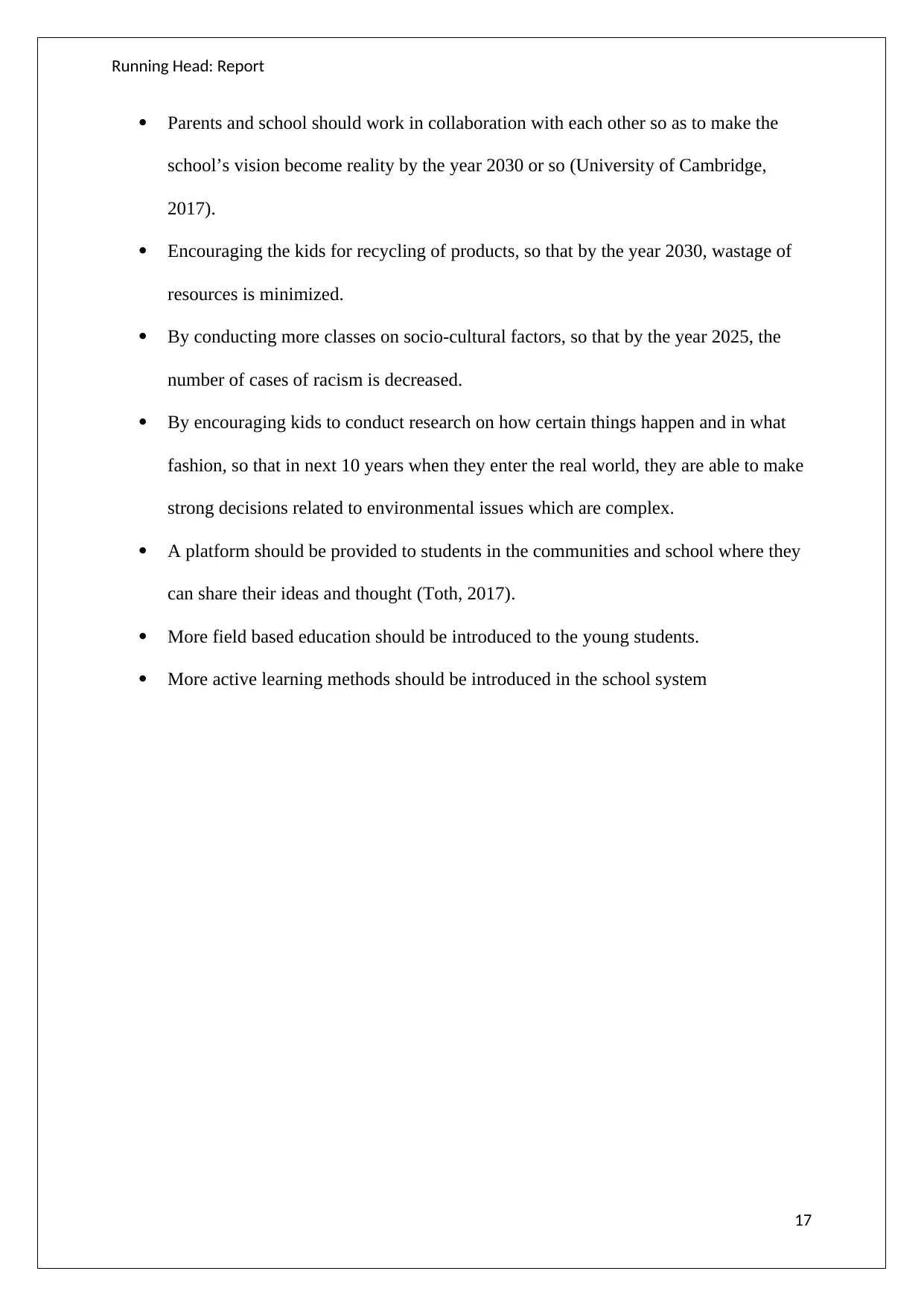
Running Head: Report
Parents and school should work in collaboration with each other so as to make the
school’s vision become reality by the year 2030 or so (University of Cambridge,
2017).
Encouraging the kids for recycling of products, so that by the year 2030, wastage of
resources is minimized.
By conducting more classes on socio-cultural factors, so that by the year 2025, the
number of cases of racism is decreased.
By encouraging kids to conduct research on how certain things happen and in what
fashion, so that in next 10 years when they enter the real world, they are able to make
strong decisions related to environmental issues which are complex.
A platform should be provided to students in the communities and school where they
can share their ideas and thought (Toth, 2017).
More field based education should be introduced to the young students.
More active learning methods should be introduced in the school system
17
Parents and school should work in collaboration with each other so as to make the
school’s vision become reality by the year 2030 or so (University of Cambridge,
2017).
Encouraging the kids for recycling of products, so that by the year 2030, wastage of
resources is minimized.
By conducting more classes on socio-cultural factors, so that by the year 2025, the
number of cases of racism is decreased.
By encouraging kids to conduct research on how certain things happen and in what
fashion, so that in next 10 years when they enter the real world, they are able to make
strong decisions related to environmental issues which are complex.
A platform should be provided to students in the communities and school where they
can share their ideas and thought (Toth, 2017).
More field based education should be introduced to the young students.
More active learning methods should be introduced in the school system
17
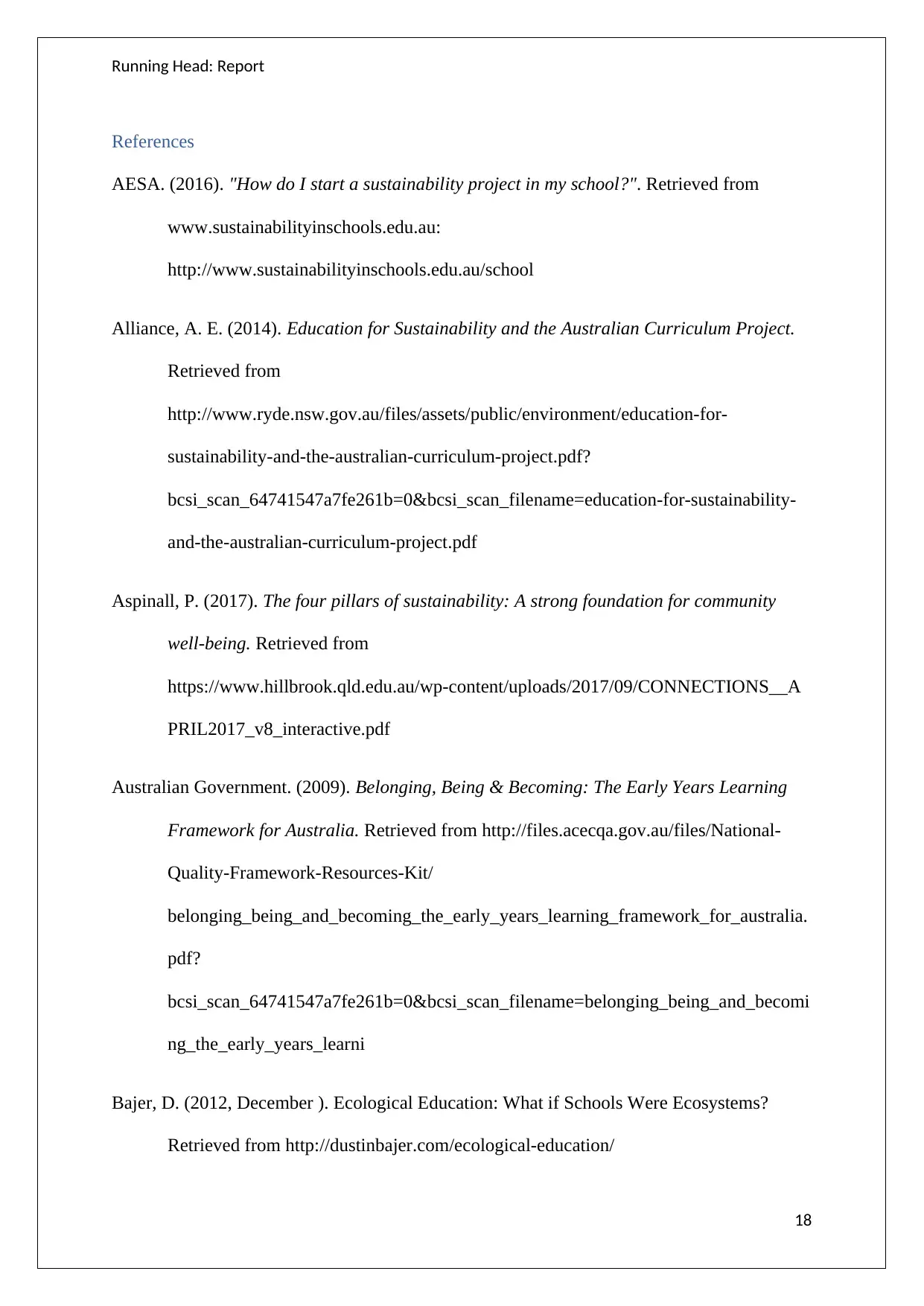
Running Head: Report
References
AESA. (2016). "How do I start a sustainability project in my school?". Retrieved from
www.sustainabilityinschools.edu.au:
http://www.sustainabilityinschools.edu.au/school
Alliance, A. E. (2014). Education for Sustainability and the Australian Curriculum Project.
Retrieved from
http://www.ryde.nsw.gov.au/files/assets/public/environment/education-for-
sustainability-and-the-australian-curriculum-project.pdf?
bcsi_scan_64741547a7fe261b=0&bcsi_scan_filename=education-for-sustainability-
and-the-australian-curriculum-project.pdf
Aspinall, P. (2017). The four pillars of sustainability: A strong foundation for community
well-being. Retrieved from
https://www.hillbrook.qld.edu.au/wp-content/uploads/2017/09/CONNECTIONS__A
PRIL2017_v8_interactive.pdf
Australian Government. (2009). Belonging, Being & Becoming: The Early Years Learning
Framework for Australia. Retrieved from http://files.acecqa.gov.au/files/National-
Quality-Framework-Resources-Kit/
belonging_being_and_becoming_the_early_years_learning_framework_for_australia.
pdf?
bcsi_scan_64741547a7fe261b=0&bcsi_scan_filename=belonging_being_and_becomi
ng_the_early_years_learni
Bajer, D. (2012, December ). Ecological Education: What if Schools Were Ecosystems?
Retrieved from http://dustinbajer.com/ecological-education/
18
References
AESA. (2016). "How do I start a sustainability project in my school?". Retrieved from
www.sustainabilityinschools.edu.au:
http://www.sustainabilityinschools.edu.au/school
Alliance, A. E. (2014). Education for Sustainability and the Australian Curriculum Project.
Retrieved from
http://www.ryde.nsw.gov.au/files/assets/public/environment/education-for-
sustainability-and-the-australian-curriculum-project.pdf?
bcsi_scan_64741547a7fe261b=0&bcsi_scan_filename=education-for-sustainability-
and-the-australian-curriculum-project.pdf
Aspinall, P. (2017). The four pillars of sustainability: A strong foundation for community
well-being. Retrieved from
https://www.hillbrook.qld.edu.au/wp-content/uploads/2017/09/CONNECTIONS__A
PRIL2017_v8_interactive.pdf
Australian Government. (2009). Belonging, Being & Becoming: The Early Years Learning
Framework for Australia. Retrieved from http://files.acecqa.gov.au/files/National-
Quality-Framework-Resources-Kit/
belonging_being_and_becoming_the_early_years_learning_framework_for_australia.
pdf?
bcsi_scan_64741547a7fe261b=0&bcsi_scan_filename=belonging_being_and_becomi
ng_the_early_years_learni
Bajer, D. (2012, December ). Ecological Education: What if Schools Were Ecosystems?
Retrieved from http://dustinbajer.com/ecological-education/
18
Paraphrase This Document
Need a fresh take? Get an instant paraphrase of this document with our AI Paraphraser
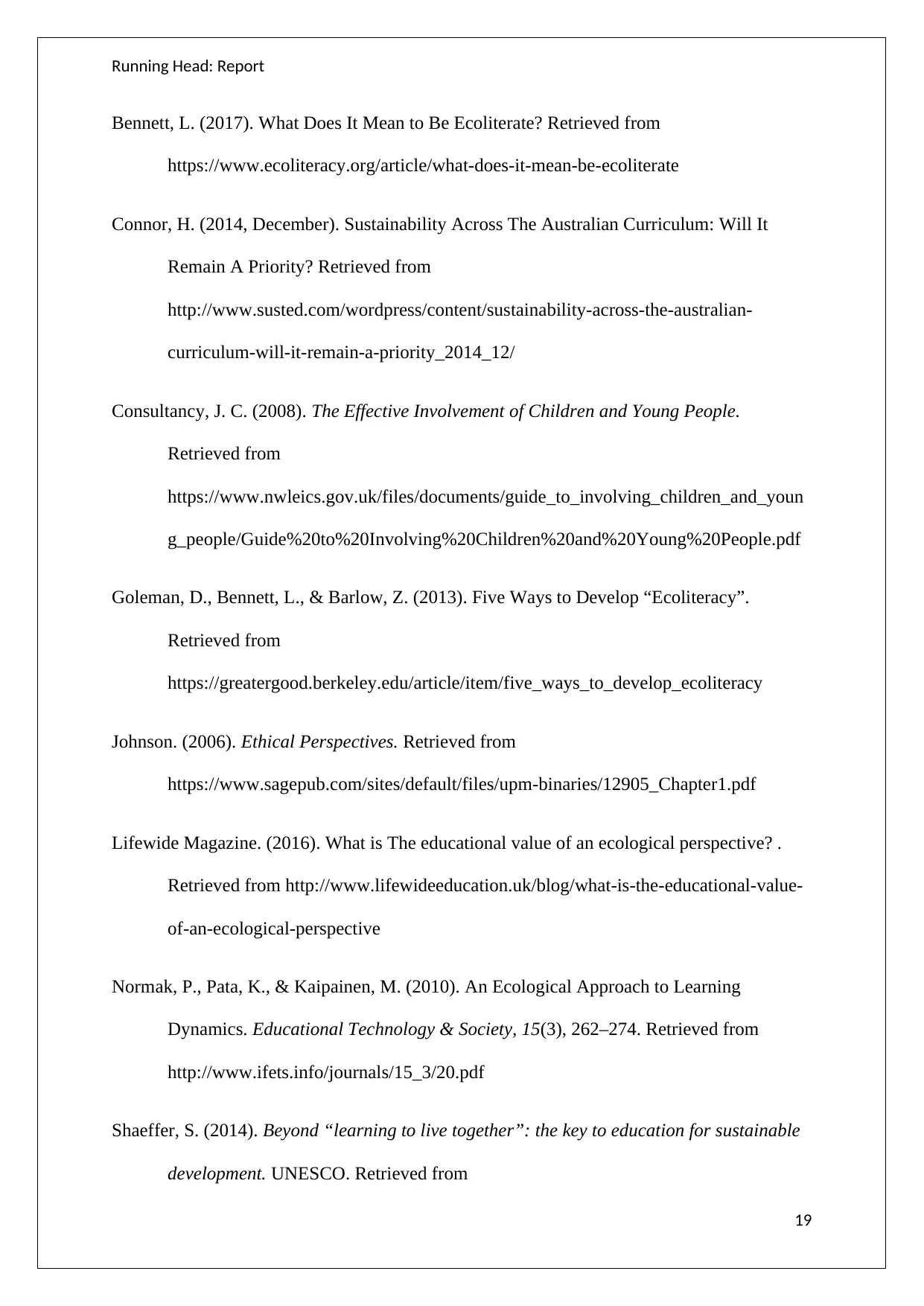
Running Head: Report
Bennett, L. (2017). What Does It Mean to Be Ecoliterate? Retrieved from
https://www.ecoliteracy.org/article/what-does-it-mean-be-ecoliterate
Connor, H. (2014, December). Sustainability Across The Australian Curriculum: Will It
Remain A Priority? Retrieved from
http://www.susted.com/wordpress/content/sustainability-across-the-australian-
curriculum-will-it-remain-a-priority_2014_12/
Consultancy, J. C. (2008). The Effective Involvement of Children and Young People.
Retrieved from
https://www.nwleics.gov.uk/files/documents/guide_to_involving_children_and_youn
g_people/Guide%20to%20Involving%20Children%20and%20Young%20People.pdf
Goleman, D., Bennett, L., & Barlow, Z. (2013). Five Ways to Develop “Ecoliteracy”.
Retrieved from
https://greatergood.berkeley.edu/article/item/five_ways_to_develop_ecoliteracy
Johnson. (2006). Ethical Perspectives. Retrieved from
https://www.sagepub.com/sites/default/files/upm-binaries/12905_Chapter1.pdf
Lifewide Magazine. (2016). What is The educational value of an ecological perspective? .
Retrieved from http://www.lifewideeducation.uk/blog/what-is-the-educational-value-
of-an-ecological-perspective
Normak, P., Pata, K., & Kaipainen, M. (2010). An Ecological Approach to Learning
Dynamics. Educational Technology & Society, 15(3), 262–274. Retrieved from
http://www.ifets.info/journals/15_3/20.pdf
Shaeffer, S. (2014). Beyond “learning to live together”: the key to education for sustainable
development. UNESCO. Retrieved from
19
Bennett, L. (2017). What Does It Mean to Be Ecoliterate? Retrieved from
https://www.ecoliteracy.org/article/what-does-it-mean-be-ecoliterate
Connor, H. (2014, December). Sustainability Across The Australian Curriculum: Will It
Remain A Priority? Retrieved from
http://www.susted.com/wordpress/content/sustainability-across-the-australian-
curriculum-will-it-remain-a-priority_2014_12/
Consultancy, J. C. (2008). The Effective Involvement of Children and Young People.
Retrieved from
https://www.nwleics.gov.uk/files/documents/guide_to_involving_children_and_youn
g_people/Guide%20to%20Involving%20Children%20and%20Young%20People.pdf
Goleman, D., Bennett, L., & Barlow, Z. (2013). Five Ways to Develop “Ecoliteracy”.
Retrieved from
https://greatergood.berkeley.edu/article/item/five_ways_to_develop_ecoliteracy
Johnson. (2006). Ethical Perspectives. Retrieved from
https://www.sagepub.com/sites/default/files/upm-binaries/12905_Chapter1.pdf
Lifewide Magazine. (2016). What is The educational value of an ecological perspective? .
Retrieved from http://www.lifewideeducation.uk/blog/what-is-the-educational-value-
of-an-ecological-perspective
Normak, P., Pata, K., & Kaipainen, M. (2010). An Ecological Approach to Learning
Dynamics. Educational Technology & Society, 15(3), 262–274. Retrieved from
http://www.ifets.info/journals/15_3/20.pdf
Shaeffer, S. (2014). Beyond “learning to live together”: the key to education for sustainable
development. UNESCO. Retrieved from
19
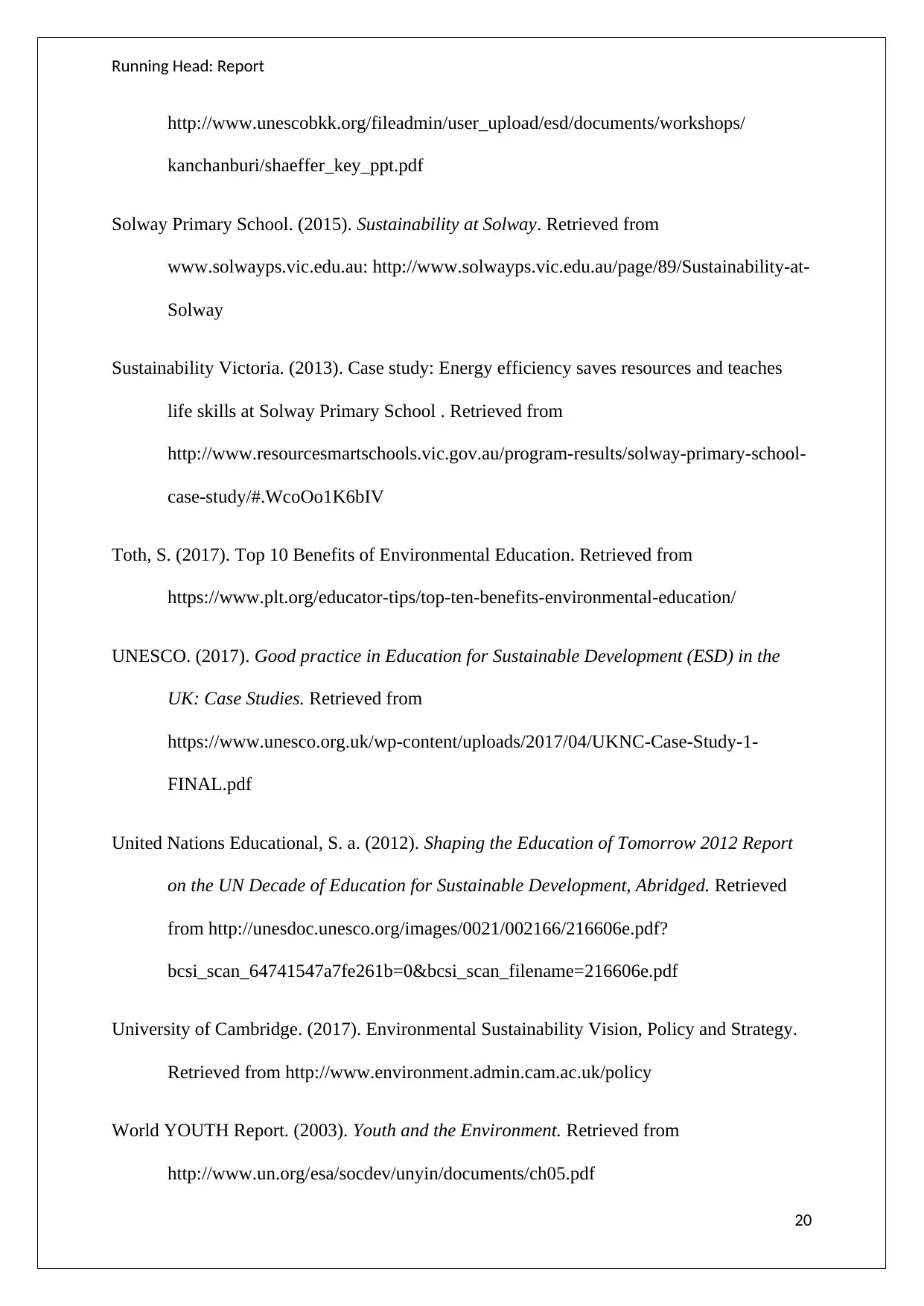
Running Head: Report
http://www.unescobkk.org/fileadmin/user_upload/esd/documents/workshops/
kanchanburi/shaeffer_key_ppt.pdf
Solway Primary School. (2015). Sustainability at Solway. Retrieved from
www.solwayps.vic.edu.au: http://www.solwayps.vic.edu.au/page/89/Sustainability-at-
Solway
Sustainability Victoria. (2013). Case study: Energy efficiency saves resources and teaches
life skills at Solway Primary School . Retrieved from
http://www.resourcesmartschools.vic.gov.au/program-results/solway-primary-school-
case-study/#.WcoOo1K6bIV
Toth, S. (2017). Top 10 Benefits of Environmental Education. Retrieved from
https://www.plt.org/educator-tips/top-ten-benefits-environmental-education/
UNESCO. (2017). Good practice in Education for Sustainable Development (ESD) in the
UK: Case Studies. Retrieved from
https://www.unesco.org.uk/wp-content/uploads/2017/04/UKNC-Case-Study-1-
FINAL.pdf
United Nations Educational, S. a. (2012). Shaping the Education of Tomorrow 2012 Report
on the UN Decade of Education for Sustainable Development, Abridged. Retrieved
from http://unesdoc.unesco.org/images/0021/002166/216606e.pdf?
bcsi_scan_64741547a7fe261b=0&bcsi_scan_filename=216606e.pdf
University of Cambridge. (2017). Environmental Sustainability Vision, Policy and Strategy.
Retrieved from http://www.environment.admin.cam.ac.uk/policy
World YOUTH Report. (2003). Youth and the Environment. Retrieved from
http://www.un.org/esa/socdev/unyin/documents/ch05.pdf
20
http://www.unescobkk.org/fileadmin/user_upload/esd/documents/workshops/
kanchanburi/shaeffer_key_ppt.pdf
Solway Primary School. (2015). Sustainability at Solway. Retrieved from
www.solwayps.vic.edu.au: http://www.solwayps.vic.edu.au/page/89/Sustainability-at-
Solway
Sustainability Victoria. (2013). Case study: Energy efficiency saves resources and teaches
life skills at Solway Primary School . Retrieved from
http://www.resourcesmartschools.vic.gov.au/program-results/solway-primary-school-
case-study/#.WcoOo1K6bIV
Toth, S. (2017). Top 10 Benefits of Environmental Education. Retrieved from
https://www.plt.org/educator-tips/top-ten-benefits-environmental-education/
UNESCO. (2017). Good practice in Education for Sustainable Development (ESD) in the
UK: Case Studies. Retrieved from
https://www.unesco.org.uk/wp-content/uploads/2017/04/UKNC-Case-Study-1-
FINAL.pdf
United Nations Educational, S. a. (2012). Shaping the Education of Tomorrow 2012 Report
on the UN Decade of Education for Sustainable Development, Abridged. Retrieved
from http://unesdoc.unesco.org/images/0021/002166/216606e.pdf?
bcsi_scan_64741547a7fe261b=0&bcsi_scan_filename=216606e.pdf
University of Cambridge. (2017). Environmental Sustainability Vision, Policy and Strategy.
Retrieved from http://www.environment.admin.cam.ac.uk/policy
World YOUTH Report. (2003). Youth and the Environment. Retrieved from
http://www.un.org/esa/socdev/unyin/documents/ch05.pdf
20
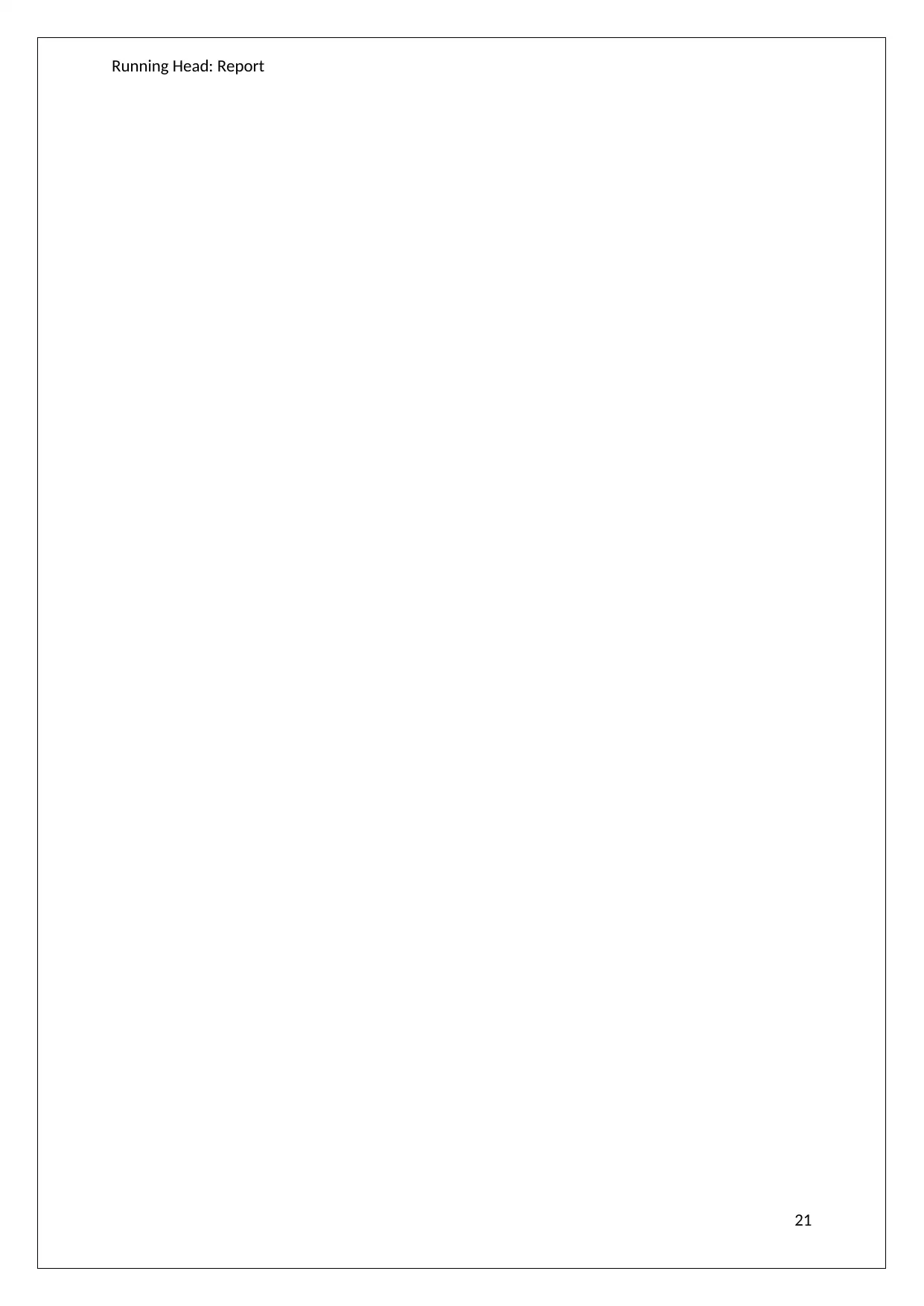
Running Head: Report
21
21
1 out of 22
Your All-in-One AI-Powered Toolkit for Academic Success.
+13062052269
info@desklib.com
Available 24*7 on WhatsApp / Email
![[object Object]](/_next/static/media/star-bottom.7253800d.svg)
Unlock your academic potential
© 2024 | Zucol Services PVT LTD | All rights reserved.
